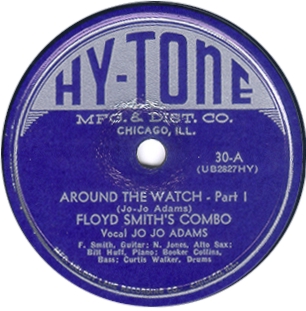

Revision note. In August 2018, Hy-Tone 36 finally showed up, on the indispensable archive.org (https://archive.org/details/78_stop-my-evil-ways_jack-cooley-mr-blues-cooley_gbia0064396b/Stop+My+Evil+Ways+-+Jack+Cooley+Mr.+Blues.flac). It was by Jack Cooley. Internet Archive has now also made Hy-Tone 36 A available; it was held back initially because the side was in Good condition only and hard to transfer. Now knowing that Hy-Tone 36-A has HY40 in the trail-off shellac, we were able to place the St. Louis Jimmy sides that were made for Hy-Tone and acquired by Opera on this session. And Cooley's A side tune, "Something I'm Going to Be," was included, just two months later, in a marathon session by Dwight "Gatemouth" Moore for King. The band was led by … Bill Martin.
Hy-Tone, owned and operated by Chicago banjoist, guitarist, and bandleader Freddie Williams and jukebox entrepreneur Nathan Rothner from 1946 through 1948, typified the resurgence of recording activity in Chicago after World War II. The tiny company was among the earliest of the small independent labels that emerged and seized the rhythm and blues market from the majors: RCA Victor, Columbia, and Decca. The label could hardly be counted as a commercial success; it expired after a three-year run, with 27 known releases and 54 sides to its name. But by discovering a wide array of talent in Chicago's flourishing South Side nightlife scene—notably blues shouters Crown Prince Waterford and Memphis Slim, blues balladeer Jo Jo Adams, electric guitar pioneer Floyd Smith, deep blues pianist Sunnyland Slim, and local tenor sax legend T. S. Mims, Sr.—Freddie Williams and Nathan Rothner did more than help to launch the recording careers of artists who achieved much more success elsewhere. They created a legacy of valued recordings, helping in their own small way to sustain Chicago as a rhythm and blues recording Mecca.
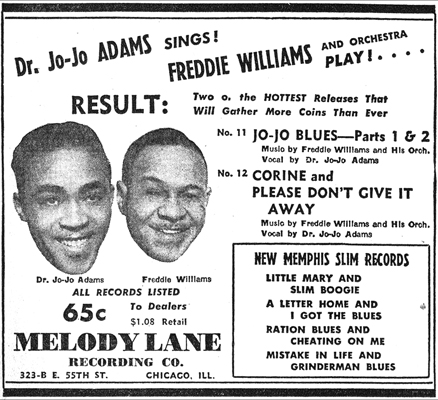
Hy-Tone was originally established as the Melody Lane Recording Co. in March of 1946. On March 16, an ad in Billboard announced the formation of the company and the release of four sides by blues crooner Jo Jo Adams backed by the Freddie Williams Orchestra. The ad also listed the impending release of eight Memphis Slim sides—although it appears that two had actually already come out by then.
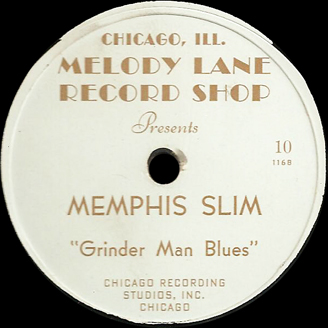
The first three releases, two featuring blues shouter Jo Jo Adams and one featuring Memphis Slim, appeared on the Melody Lane Record Shop imprint. Just two weeks later—as reported in a story in the April 6 issue of Billboard (by-line dated March 30) and an ad in the same issue—the label name was changed to Hy-Tone and the company name was changed to Hy-Tone Mfg. & Distrib. Co. With the name change and the reorganization Williams was joined by a partner, Nathan Rothner, who had been in the jukebox business since 1942. Chicago Recording Company and Mercury Records were handling the pressing and Hy-Tone was planning to crank out 12,000 copies per week of Hy-Tone 12 and 13. Demand for these sides is unlikely to have met expectations...
Nathan Rothner was born July 28, 1910 in Russia, and came to Chicago with his family in 1920. They settled on the near West Side, where he attended Medill High. Rothner entered the printing trade after finishing high school, but in 1942 he got involved in jukebox distribution. His cousin brought him into a faltering business when he could not repay a $3,500 loan. Rothner saved the business with a serendipitous deal.
This was an era when the jukebox business was booming. First they had 10-record machines, then 12, then 16, then 20, then 100. Well, he had a lot of good locations, but we had old-fashioned machines. But I met a jukebox distributor who had new machines, but he had a route which the man never paid for. The route was lousy, with machines in beauty parlors and such, but the machines were modern. We had little cash, but good credit, and because of that I was able to pick up those machines and put them on our good routes, and we prospered (telephone interview with Robert Pruter, September 30, 2002)
When Williams approached him in March of 1946, he was ready to expand his interests into the record business.
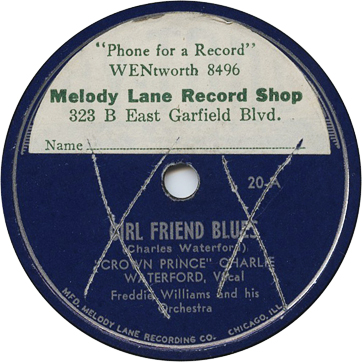
The original address of the Melody Lane Recording Company was 323-B East 55th Street, Chicago—-the address of the Melody Lane Record Shop, owned by Williams. In the mid-1940s, 55th Street, also called Garfield Boulevard, was one of the peppiest streets for South Side nightlife. The major clubs it boasted included the Club DeLisa (5521 South State), Cafe De Society (309 East Garfield), the Hurricane Show Lounge (349 East Garfield), and the Rhumboogie Club (343 East Garfield). The last (for details see our Rhumboogie page) was probably the most prestigious of the clubs on the street, though it was on its way downhill by then. Thus, Williams was placed right in the center of a hot entertainment area, where he probably was inspired to record some of the talent he saw in the nearby clubs.
When Nathan Rothner came on board, the company moved from the record shop to a building that Rothner owned at 1214 Blue Island Avenue. But Rothner was always selling and buying buildings, and by September 1946 the peripatetic company had moved to the city's near North Side at 1521 West Walton Street. By June 1947 Hy-Tone (full name now Hy-Tone Recording Co.) was located at 1615 South Wabash, sharing quarters with Independent Record Distributors, which advertised itself as a distributor of "indie" labels and "party" records. Independent was practically next door, at 1611 S. Wabash in February 1948, while Hy-Tone was now also domiciled at 1611. Rothner did not recollect operating under that name Independent Record Distributors, and the name did not ring a bell with him when interviewed, but we believe it was his company, because in 1949 both Hy-Tone, which had gone inactive by that time, and Independent Record Distributors moved to 118 East 30th Street. And both were still there in July 1950.
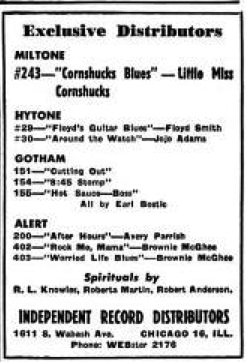
According to the Musicians Union Death Files (now housed in the Chicago Public Library), Freddie Williams was born on September 22, 1898. His obituary in the Chicago Defender gave his place of birth was Pensacola, Florida. Williams' family probably moved to the Boston area when he was a young child, because Charles Walton recalls that he spoke with a Boston accent. Williams paid his way through the Boston Conservatory of Music by working summer resorts. In a somewhat garbled story in 1953 for the Chicago Defender, Williams said his first "major job" was with the Fletcher Henderson orchestra in the 1920s. He joined Local 208 in Chicago in 1929. The Defender story didn't mention what instrument he played, but we have learned that he played the banjo in the 1930s and subsequently switched to guitar (Charles Walton recalled him as a guitarist). In the Defender piece, Williams stated that his bandleading career began with his "Gold Coast" band that "played many of the leading Chicago night spots... where rich heiresses and the millionaire crowd, including the McCormicks, the Armours, and the Swifts, accounted for 80 per cent of the trade." Drummer Floyd Campbell told Dempsey J. Travis in An Autobiography of Black Jazz that when he arrived in Chicago in 1930, he was hired by Williams to play at an "exclusive white nightclub on the near North Side."
Williams also built a considerable reputation on the South Side, playing many of the principal venues. For example, on November 29, 1933, when Sol Rubin reopened the famed Dreamland Cafe in its new location (it had moved from 35th and State to 47th and State), "Freddie Williams and His Gold Coast Orchestra" was the featured band. It played there until at least the end of the year. In his column "The Orchestras" for December 9, 1933, Jack Ellis reported:
Freddie Williams and His Gold Coast Orchestra are swinging at the Dreamland, 47th and State Sts. The [word obscured]: Prentis McCray, piano; Clifford (Snag) Johnson, drums; Willie Randall, sax; Richard Jones, trumpet; and Freddie on the 'jo.'"
We think the drummer was really Clifford "Snags" Jones (1900-1947), who came up from New Orleans. The pianist was definitely Prentice McCarey (1909-1992), who later became a regular in King Kolax's combos of the 1950s; he was 24 years old at the time. Alto saxophonist Willie Randall remained on the scene through the 1950s, recording in 1948 with a band assembled by Al Benson (later released on Old Swing-Master). It's been a really long time since anyone said "'jo" for banjo...
Unfortunately, Freddie Williams was enjoying his greatest success as a bandleader while the Depression was wiping out some record companies and forcing major cutbacks at others; little jazz recording was happening in Chicago then, and most Chicago artists from the 1930s went unrepresented or underrepresented on 78s.
Later, Williams said, he toured Europe and the Far East with Sam Wooding, and "returning home" toured the United States with such shows as Shuffle Along and Lew Leslie's Blackbirds. Upon returning to Chicago he worked with the Erskine Tate and Jimmy Noone orchestras.
In the 1953 piece, Defender writer Rob Roy inaccurately described Williams as being "featured" at the 1933 Chicago World's Fair, in the famed Streets of Paris revue that presented fan dancer Sally Rand. The reality was a little different. During the Chicago World's Fair of 1933-34, fan dancer Sally Rand was creating a sensation. On August 4, 1934, Sally Rand and her twenty person revue, plus her backing band led by Art Frasik, appeared at a special midnight fundraiser show for the NAACP at the Regal Theater. Also on the bill was a host of entertainers from the black community, including three notable bands—those of Jesse Stone, Claude Hopkins, and Walter Dyett. A week later, the H. T. Cafe (3443 South State) to get in on the Sally Rand phenomenon and draw a few customers featured "Clottle Bass, Fan Dancer, direct from the Streets of Paris," backed by Freddie Williams and His Gold Coast Orchestra. In his column "The Orchestras," Jack Ellis reported in the August 4, 1934 Defender that "Freddie Williams, banjo, the little man with big ideas, is not only leading his band, but is the general manager of the Travis Cafe, 3445 State Street. Freddie will open, August 8. Hobart Clardy, saxophone, Raff Teravolo, piano, and Pete Peterson, drums, are his strong end men." (The saxophonist's name is spelled "Hobert" is other sources. The pianist seems to be Ralph Tervalon, who recorded in Chicago in the 1940s and the 1950s and always had trouble getting his name spelled correctly.) It is apparent that H.T. was the initials of the proprietor, one Mr. Travis, and that Williams' group was less imposing than its name suggested.
In February 1936, Defender ads reveal that Freddie Williams and his Gold Coast Orchestra were used to play behind a no-name revue at the Regal Theater every Sunday during the month.
On March 7, 1941, Freddie Williams filed a card with the Union indicating that he played the guitar. He had probably made the instrument switch earlier. In fact, he was featured on the steel guitar in the bands that he led.
Williams, like some other leaders of the older generation (e.g., Floyd Campbell), started having a lot of difficulty in the band business during World War II. Not only were fashions changing, but too many of his musicians were being drafted. In 1941, after consulting with a friend who owned a record store on 58th Street, Williams opened Melody Lane Record Shop under the El on 55th Street. Thereafter his sole business was selling records. Billboard in 1948 described him as a "Negro juke box king," but this appears to have confused the record label (possibly also the distributorship), in which Williams had an interest, with the jukebox operation, which was strictly Rothner's.
Freddie Williams must be accorded the status of a pioneer in the postwar Chicago independent recording industry. In 1945, the race market recording industry was still in the hands of the majors, primarily Columbia and RCA Victor. Williams had to find artists that the majors had not already tied up. These would not be established recording artists but up-and-coming performers, without a reputation but with fresh new sounds. Thus, when Williams set up his operation in early 1946, he was in a position to record Memphis Slim, Jo Jo Adams, Floyd Smith, Charles "Crown Prince" Waterford, Sunnyland Slim, and Bill Martin. Of these, only Memphis Slim had previously done any recording for a major label as a leader.
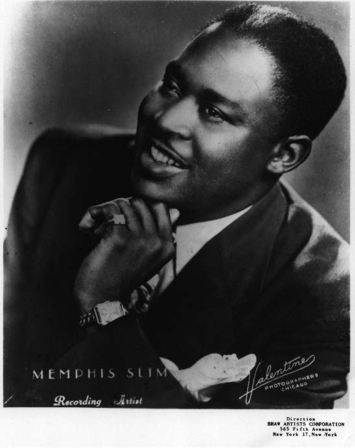
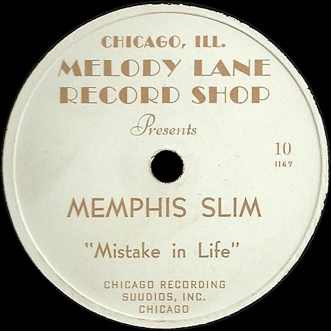

Memphis Slim (voc, p); prob. Cyril J. "Cozy" Eggleston (ts); Ernest "Big" Crawford (b).
Chicago Recording Studios, Chicago, c. January 1946
| 1165-D [5664*] |
Got The Blues [Now I Got the Blues*] | Hy-Tone 18, King 4284-B*, Blues Collection [Fr] 159862 [CD] | |
| 1166-D [5666*] |
Don't Ration Love [Don't Ration My Love*] | Hy-Tone 18, King 4327 A*, Blues Collection [Fr] 159862 [CD] | |
| 1168 on label; 1167-(2) in trailoff on Melody Lane 1168-H on label; 1167-(2) in trailoff on Hy-Tone 1167-2 on label; probably 1167 in trailoff on Hy-Tone |
Grinder Man Blues | Melody Lane Record Shop 10, Hy-Tone 10B%, Blues Collection [Fr] 159862 [CD] | |
| 1167 on label; 1168-B in trailoff on Melody Lane 1167-H on label; 1168-B-1 in trailoff on Hy-Tone 1168 on label on Hy-Tone [?] |
Mistake in Life | Melody Lane Record Shop 10, Hy-Tone 10A%, Blues Collection [Fr] 159862 [CD] |
We got our basic information on this session from Leadbitter, Fancourt, and Pelletier (1994). However, LFP were not aware that four of the King releases of Memphis Slim's Hy-Tone titles were in fact remakes (done in Cincinnati, in January 1949) rather than reissues of the Melody Lane or Hy-Tone originals. (LFP listed too many musicians on the Hy-Tone sessions, because the King remakes employed a 4-piece band with Alex Atkins, alto sax; Timothy Overton, tenor sax; and Betty Dupree Overton, bass.)
The true personnel on the first Hy-Tone session is a trio, quite possibly the same one that Slim led at the Flame Lounge. We are indebted to Jean Buzelin's liner notes to the Memphis Slim Blues Collection CDs for pointing out that four of the King sides were remakes: specifically, the "Mistake in Life" on King 4324 (and subsequent King or King-derived releases) and the "Grinder Man Blues" on King 4312 et seq. The King "Grinder Man" is better structured—it doesn't begin in medias res like the Hy-Tone—but the Hy-Tone version is much livelier, largely because of the interplay between Slim and his tenorist.
Buzelin puts Ernest Cotton on tenor sax and Big Crawford on bass for this session. However, Slim refers to "Mr. Cozy" twice (once on "Now I Got the Blues" and once on "Grinder Man"). And the tenorist sounds like Cozy Eggleston. So we have penciled him in for this session.
The first Memphis Slim issue appeared on an imprint called Melody Lane; the release number was 10, and there is every reason to think this was the first single that Freddie Williams put out. The titles were "Mistake in Life" and "Grinder Man Blues." April 1946 saw the re-release of these sides on the newly inaugurated Hy-Tone imprint, with the same release number. While the March 16 Billboard spoke of the Memphis Slim sides as though maybe none had been released yet, the Melody Lane Record Shop release with an earlier number seems to belie that notion.
Chicago Recording Studios was an outfit located at 64 East Jackson Boulevard. It was about a decade old by this time.
A copy of Melody Lane 10 in the collection of Helge Thygesen shows "Mistake in Life" with 1167 on the label, but 1168 in wax, and the converse for "Grinder Man Blues." The sides play correctly as titled.
A copy of Hy-Tone 10 in the collection of Dan Kochakian shows the same inconsistency. He reports that the matrix numbers with the H suffix appear on the labels of Hy-Tone 10, the matrix numbers with numerical suffixes are incised in the trail-off.
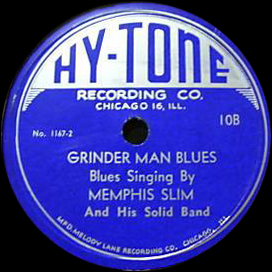
More recently, we have seen a Hy-Tone 10 label that appears to be unreversed: it shows 1167-2, not 1168-H, on the label for Side B. Obviously Hy-Tone 10 will repay some further investigations into label variants.
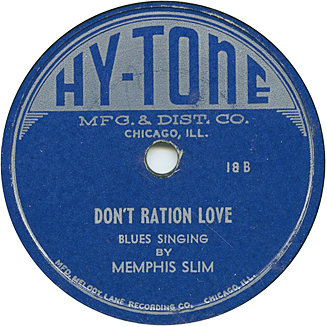
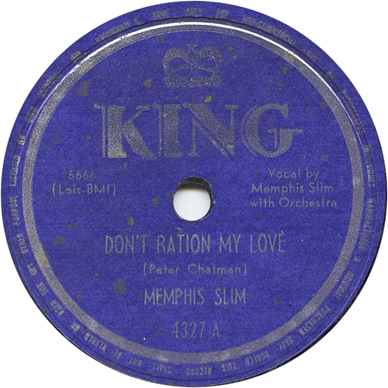
The other two Melody Lane sides—"Got the Blues" and "Don't Ration Love"—appeared later in the year on Hy-Tone 18.
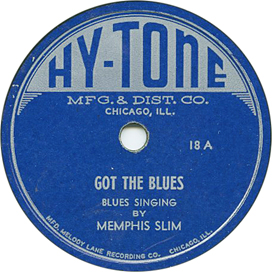
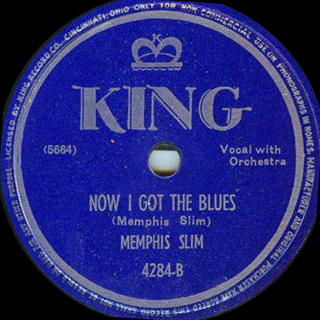
Blues Collection 159862, Memphis Slim: The Complete Recordings Vol. 2: 1946-1948 is a French CD released in 2000. Besides being the first to carry all of Slim's Hy-Tone recordings, the CD includes his subsequent work for Miracle from "Kilroy Has Been Here" through "Angel Child."
Memphis Slim, blues singer and pianist, was born John L. Chatman on September 3, 1915, in Memphis, Tennessee. He moved to Chicago in 1939. He first recorded for a leader for the OKeh label in 1940, under the name Peter Chatman. By at least 1941 he was playing in Chicago clubs, and soon built a formidable reputation with his robust blues singing and his vigorous keyboard work. He cut three sessions for Bluebird in 1940 and 1941. The Hy-Tones were his first postwar sides; in fact, "Grinder Man" was a remake of one of his Bluebird recordings. Around the time of his Hy-Tone sessions, Memphis Slim was ensconced at the city's premier blues club, the Flame Lounge (3020 South Indiana Avenue), under the billing of "Memphis Slim and His Boogie Woogie Trio." On September 6, 1945, Slim (who was known to the Musicians Union as Peter Chatman) filed a 6-week contract with the Flame with Local 208. He moved over to the Triangle Tavern for 10 weeks (contract posted on November 15). The Flame brought him back in December for another 6 weeks (contract accepted and filed on December 20). Williams probably discovered Slim at the Flame while scouting for talent for his new label. On March 7, 1946, after both recording sessions had taken place, Slim filed an "indefinite" contract with the Hollywood Rendezvous.
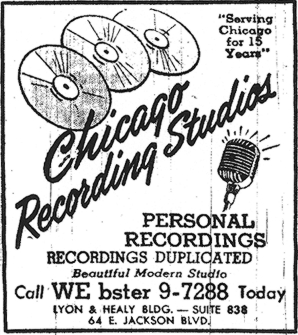
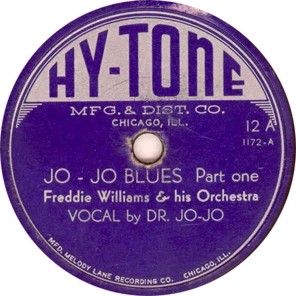
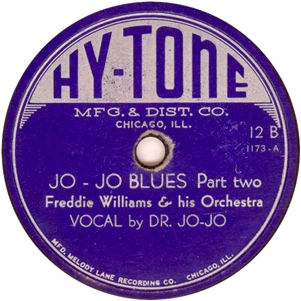
Jo Jo Adams (voc); Freddie Williams (eg, dir, arr); unidentified (tp); unidentified (ts); Nat Jones (as); unidentified (p); unidentified (b); unidentified (d).
Chicago Recording Studios, Chicago, January or February 1946
| 1172-A on Melody Lane 12 QB-4548 and 1172-H on Hy-Tone 12 |
Jo-Jo Blues Part one | Melody Lane Record Shop 12, Hy-Tone 12 A, Classics 5083 [CD] | |
| 1173-B (label and trailoff) and QB-4549 (trailoff) on Melody Lane 12 QB-4549 (1173-H) on Hy-Tone 12 |
Jo-Jo Blues Part two | Melody Lane Record Shop 12, Hy-Tone 12 B, Classics 5083 [CD] | |
| QB 4550 (1174-A) | Don't Give It Away | Melody Lane Record Shop 13, Hy-Tone 13B, Classics 5083 [CD] | |
| QB-4551 (1175-A, 1175-1) | Corine | Melody Lane Record Shop 13, Hy-Tone 13A, Classics 5083 [CD] |
This session yielded two of the first three Melody Lane releases, featuring the two-part "Jo-Jo Blues," "Don't Give It Away," and "Corine." The four sides were released on Melody Lane 12 and 13. All four sides were promptly re-released on Hy-Tone 12 and 13 (the Hy-Tone releases were mentioned in Billboard on April 6, 1946). The H suffix on the master numbers to Hy-Tone 12 was added for that release.
A copy of Hy-Tone 13 in Tom Kelly's collection shows that the QB numbers (indicating mastering and pressing by RCA Victor) appeared in the wax and the 1100 series numbers on the label. The assignments are the same on his copy of Melody Lane 13, except there only the "Corine" side carried the QB matrix number. However, there was a second label variant for Hy-Tone 13, using a different type face; on a copy in Robert Campbell's collection, the QB numbers are stamped in the trail-off area on both sides. Hy-Tone 13 was misreported as Hy-Tone 12 in previous discographies.
Meanwhile, Melody Lane 12 was previously mislisted as Melody Lane 11 (we have yet to see a copy of Melody Lane 11, and have come to question its existence). Our information on Melody Lane 12 initially derived from a copy in Mike Kredinac's collection; on the label the sides are marked 1172-A and 1173-B; the same numbers are in the wax, along with QB 4549 in the wax on the B side. The QB and 1100 series numbers for Hy-Tone 12 are derived from Leadbitter and Slaven's 1987 edition of Blues Records 1943-1970 Volume 1: A-K; these still need corroboration.
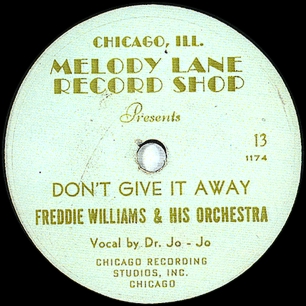
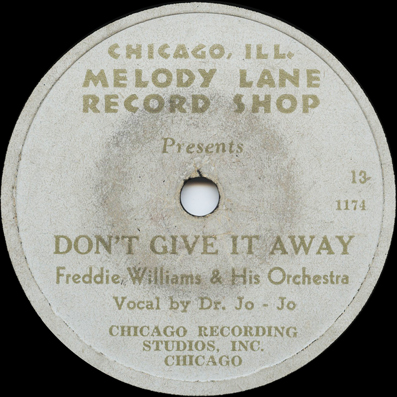
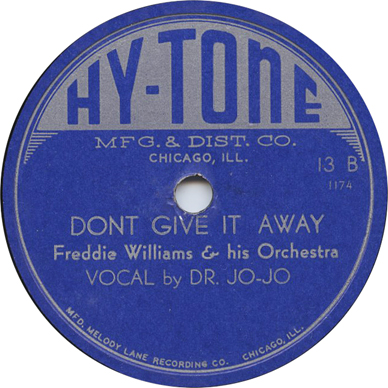
All four sides from this session were reissued for the very first time in January 2004 on Classics 5083, Jo-Jo Adams 1946-1953. This CD contains all of Jo Jo's released sides except the six he made with Tom Archia. It benefits from the excellent liner notes by Dave Penny, which add to the sparse biographical data that we have on the singer.
There is no extant personnel listing for this session. We can hear, though, that Freddie Williams uses the same instrumental lineup as on his later sessions with "Bing" Williams and Crown Prince Waterford. The trumpet player is a Swing artist who puts his mute to considerable use—not the same musician, we think, as on the later session. Williams' associate Nat Jones appears to be the altoist. The tenorist is out of Hawk—someone like Moses Gant comes to mind. The pianist, who takes the intro to Jo-Jo Blues Part 2, is a member of the Teddy Wilson school, and the drummer uses his brushes a lot.
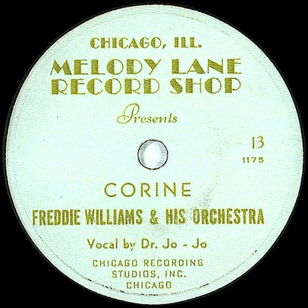
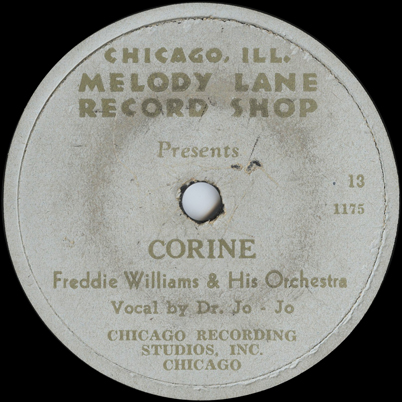
Chicago Recording Studios numbers were attached to these sides, probably indicating where the recording was done. We used to interpret QB as pointing to Quality Recording, a studio run by Milton G. Wolf at 206 South Wabash in the Loop. Quality Recording was listed in the 1945 and 1946 Chicago telephone books. However, the QB really belongs to an incomplete serial number indicating mastering and pressing by RCA Victor (and the QB 4500 numbers are stamped, in the RCA Victor manner). The long count matrix number would have had a D5 (for 1945) or D6 (1946) before the QB.
Jo Jo Adams, who was born in Alabama at an unknown date (Dave Penny has estimated it was around 1918), was a flamboyant denizen of the South Side. Adams had sung in a gospel quartet and emulated Cab Calloway, but by this point he typified the more urbane style of blues singing that prevailed in the 1940s. He also danced, told dirty jokes, and showed off his wardrobe of loudly colored formal wear with seriously elongated coattails. More often than not he doubled as MC at the clubs he played. He could have been discovered by Williams performing at the nearby Hurricane Lounge, where he headed a revue in December of 1945, or perhaps a little later at the Ritz Lounge, Oakwood and South Park, where Adams was fast building a reputation.
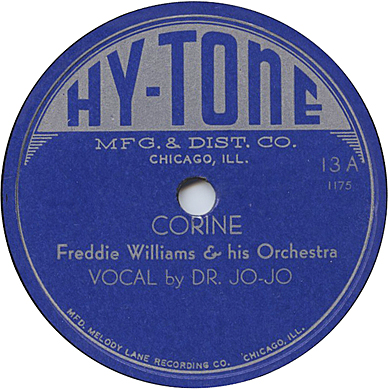
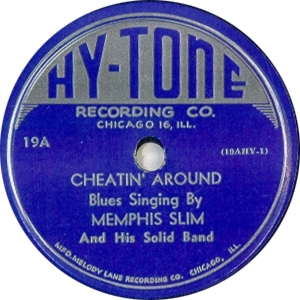
Memphis Slim (voc, p); prob. Ernest Cotton (as); poss. Tyrell "T" Dixon (d).
prob. Chicago Recording Studios, Chicago, c. February 1946
| 17 A HY | Slim's Boogie | Hy-Tone 17 A (see below), Blues Collection [Fr] 159862 [CD] | |
| 17 B HY (5668*) | Little Mary | Hy-Tone 17 B (see below), King 4324-AA*, Blues Collection [Fr] 159862 [CD] | |
| 19 A HY-1 (5662*) | Cheatin' Around | Hy-Tone 19A, King 4284-A*, Official [Dan] 6016, Blues Collection [Fr] 159862 [CD] | |
| 19 B HY-18 | A Letter Home | Hy-Tone 19B, Negro Art [F] M-12-SB-367, Blues Collection [Fr] 159862 [CD] |
Again, we got our basics of this session come from Leadbitter, Fancourt, and Pelletier, Blues Records 1943-1970 Volume 2: L-Z (1994). Since these sides appeared only on Hy-Tone, and neither carried the Chicago Recording Studios indication or matrix numbers in the 1170s, we are not completely sure where they were made. But the fact that the sides were already done when Melody Lane took out its first ad suggests a similar origin to the first two sessions.
The LP reissue on Official was filled in from Lord's Jazz Discography. LFP were not aware that two cuts from this session were remade (instead of reissued) by King after it bought Slim's two sessions from Hy-Tone in 1948. They incorrectly list a larger ensemble with two different alto saxophonists (one on Hy-Tone 17, the other on 19), a tenorist, and a bass player.
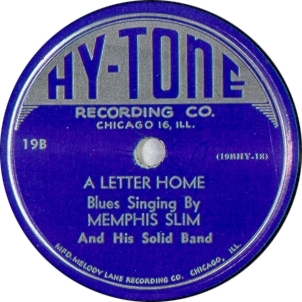
In fact, Slim's second Hy-Tone session was done with a trio. There is an alto saxophonist to whom Slim refers to at the end of "Slim's Boogie" as "Mr. Corron" or something like that, and a prominent drummer. The altoist appears to play on all 4 cuts. LFP had one Ernest "Collins" on alto on the first two, and Alex Atkins (who was in Slim's band for the Miracle sides and the King remakes) on the second two. They also had Ernest Cotton on tenor throughout, when in fact there is no second sax. We don't know of any Ernest Collins on the Chicago scene at this time. We'll go with Buzelin, who thinks Ernest Cotton (born in 1926) was the altoist; when Slim expanded his band for the Miracle recordings, Cotton played tenor. As for the drummer, Tyrell "T" Dixon had been on a Big Bill Broonzy session for Columbia in February 1945 (it was also the last sideman appearance for Buster Bennett on a Melrose sesssion), and in 1946 and 1947 was occasionally listed on Union contracts as the leader for gigs at blues clubs in Chicago. Meanwhile, Memphis Slim was working with Big Bill during this period (though not making commercial recordings with him), and Big Bill was not usually the contractor of record for gigs at Union venues in Chicago. So we are penciling in T Dixon as a possible here. Further investigation needed.
We have been able to check the matrix numbers and the label copy against copies of Hy-Tone 17 and 19 in Tom Kelly's collection. On his copy of Hy-Tone 17, the labels are reversed: "Slim's Boogie" with 17 B HY in the wax is labeled "Little Mary" with 17 A HY on the label. The composer credits on the Kings are to Memphis Slim (either under his stage name or as "Peter Chatman") but no credits appear on the Hy-Tone labels.
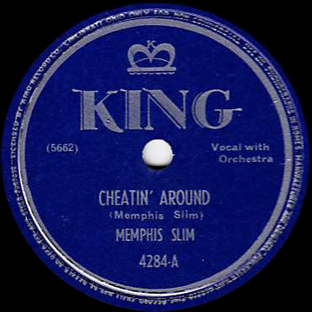
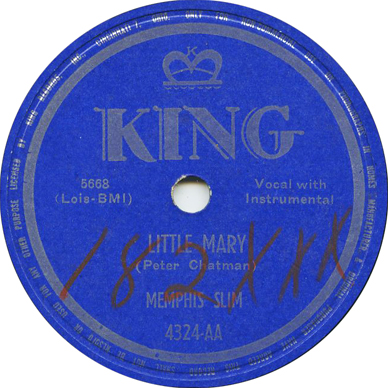
We are not including the remade version of "A Letter Home," which was released on King 4312A and used on subsequent King and King-derived issues. (The LP release on Official 6016 needs inspecting; we don't know whether it used the Hy-Tone original or the King remake.) "Slim's Boogie" on King 4312-AA is also a remake, subsequently handed down on various derivatives. The four remakes were cut in Cincinnati in January 1949, with a band including Alex Atkins, alto sax; Timothy Overton, tenor sax; and Betty Dupree Overton, bass. They are easily picked out because there were two saxes—and no drummer on any of the four.
Negro Art M-12-SB-367, Story of the Blues: Chicago Blues 3, was an LP released in France around 1968. Blues Collection 159862, Memphis Slim: The Complete Recordings Vol. 2: 1946-1948 is a French CD released in 2000. Besides all of Slim's Hy-Tone recordings (carefully distinguished from the King remakes), the CD includes his subsequent work for Miracle from "Kilroy Has Been Here" through "Angel Child."
We know that Memphis Slim's second session preceded the Melody Lane advertisement in Billboard for March 16, 1946, because the advertisement mentioned six Slim titles not yet released on Melody Lane, including "Little Mary," "Slim Boogie," "A Letter Home" and "Cheating on Me." Despite some title variation, all four are obviously from the present session. The first release from the session, on Hy-Tone 17, featured "Slim's Boogie" and "Little Mary," was quickly followed by Hy-Tone 19, featuring "Cheatin' Around" and "A Letter Home," all with unhelpful master numbers. Hy-Tone 19 featured a billing of "Memphis Slim & His Solid Band." A Flame ad from September 1946 billed the band as "Memphis Slim and His Boogie Woogie Trio," and listed Alex Atkins (alto sax) and Ernest "Big" Crawford (bass) as members.
All eight sides recorded by Memphis Slim for Hy-Tone were leased to King Records toward the end 1948, after Hy-Tone went inactive. However, just four of his Hy-Tones were actually reissued on King in 1949; the other four sides that King put out on Slim that year are remakes of the Hy-Tone titles. King routinely attached new matrix numbers to acquisitions; these can be seen above. (When a Hy-Tone side wasn't reissued on King, its matrix number got attached to the remake instead.)
Memphis Slim was launched as a major blues talent when he moved to the bigger Miracle operation in the fall of 1946. After Miracle, Slim went on to make many other critically respected recordings for the Chicago imprints of Premium, Mercury, United, Cobra, and Vee-Jay before getting himself overrecorded by a host of New York-based companies during the late 1950s and early 1960s. Slim established himself in Paris in 1962, made a bunch more records in Europe, and became quite prosperous (in 1972 he owned a Rolls-Royce). Memphis Slim resided in France until his death on February 24, 1988.
The first three sessions were completed before Freddie Williams brought in Nathan Rothner as his business partner, although nothing from the second Memphis Slim session would see release until Melody Lane had been reorganized into Hy-Tone.
Within a month of putting out his first Melody Lane releases, Freddie Williams found himself short of capital. As Rothner recalled:
He owned this record shop on 55th Street, right under the El tracks, and came to me with these masters. He asked if I wanted to be an investor in his company. I joined as a 50 percent partner.
For the remainder of 1946, Williams did the talent scouting and supervised the sessions. He also led the band and played guitar on several of them. (During 1947, as we will see, Rothner took more of a lead role.) Rothner had religious obligations as well as business commitments that prevented him from getting around the club scene much:
I was limited in what I could do. I always observed the Sabbath from Friday evening through Saturday, and that limited me from going out and hearing the music in the clubs.
The first session for Hy-Tone appears to have taken place in May.
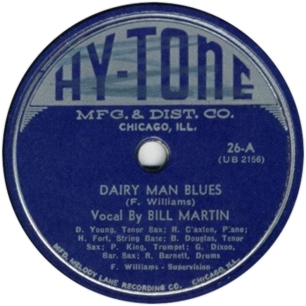
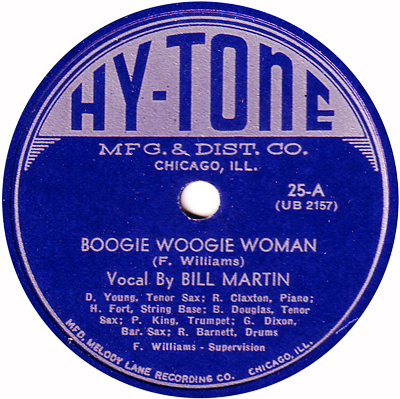
Bill Martin (voc); Paul King (tp); Buck Douglas (ts); Dave Young (ts); George Dixon (bars); Rozelle Claxton (p); Henry Fort (b); Richard Barnett (d); Freddie Williams (supervision).
United Broadcasting Studios, Chicago, c. May 1946
| UB 2156 | Dairy Man Blues (Williams) | Hy-Tone 26-A | |
| UB 2157 | Boogie-Woogie Woman (Williams) | Hy-Tone 25-A | |
| UB 2158 | Mercy, Mercy Blues (Martin) | Hy-Tone 25-B | |
| UB 2159 | Dream Blues (Martin) | Hy-Tone 26-B |
Trumpeter Bill Martin and his Orchestra dominated Hy-Tone's issues in 1947, as Williams featured him on releases 25 through 28. Martin recorded the sides in two sessions at United Broadcasting Studios. The first session featured "Mercy Mercy Blues" and "Boogie-Woogie Woman," which were paired for release on Hy-Tone 25; and "Dairy Man Blues" and "Dream Blues," which were paired on Hy-Tone 26. According to Leadbitter, Fancourt, and Pelletier (1994), Martin did not play trumpet on his Hy-Tone sessions (this appears to have been the case; Paul King gets the trumpet credits on Hy-Tone 25 and 26, while Gail Brockman gets the credit on Hy-Tone 27 and 28).
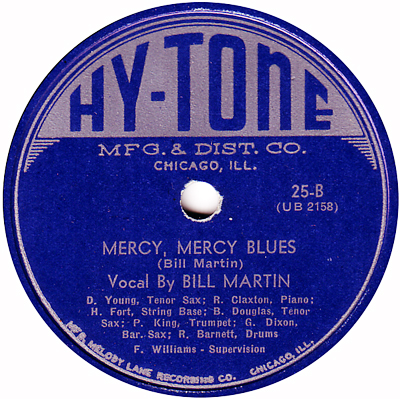
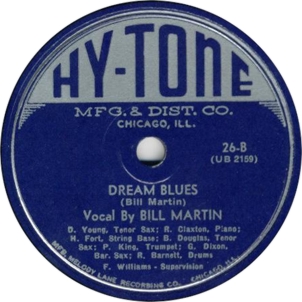
Leadbitter et al. derived their listing from the Hy-Tone labels, which helpfully give the names of the musicians, though with first initials only.
According to drummer Charles Walton, Bill Martin was not primarily known for his chops on the trumpet: "Martin was really something of a con man, he had the gift of gab." Martin, who was born December 25, 1914 in Alabama, spent the earlier part of his musical career in Kansas City, arriving in Chicago during World War II with several other musicians. In Living Blues #149 (Jan-Feb 2000) a story on pianist Roy Searcy, brother of pianist Bill Searcy, features a 1939 photo that shows the Bill Martin Band at the the legendary Reno Club, which Roy declares was "the number one club for the black musician in America." Besides Bill Martin and Bill Searcy, there are five other musicians and a canary singer. By 1946, no fewer than three of these other band members (bassist Lowell Pointer, saxophonist Buck Douglas, and clarinetist Bill Douglas) had joined the migration to Chicago.
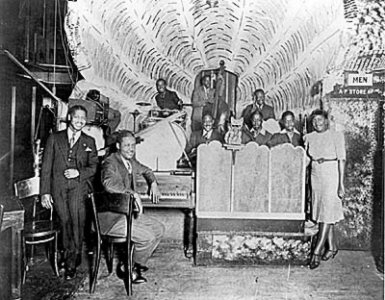
Bill Martin joined Musicians Union Local 208 in Chicago on October 1, 1943. For several months in 1945 he worked in the spirited combo led by bassist Dallas Bartley; they recorded four sides for the Cosmo label and backed Dwight "Gatemouth" Moore for National. The Bartley band also made three "soundies" in May 1945; Martin can be seen singing all three numbers and playing trumpet on them. In February 1946, Martin signed an "indefinite" contract with the 528 Club (accepted and filed by Musicians Union Local 208 on February 7). However, Martin did not have a good experience as a bandleader. He promptly got into hot water with Local 208: he failed to pay "local tax" on his engagements, and was overheard telling a clubowner that he planned to use non-Union musicians on a gig—see Board minutes for April 4, 1946. He seems to have joined Hillard Brown's combo (already in residence at Joe's Deluxe Club) after his failed experiment at bandleading.
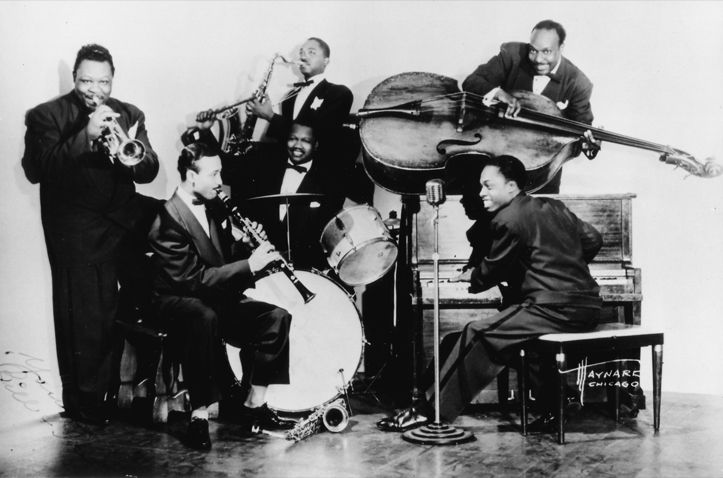
Walton recalled that when he first ran into Martin, around 1946, the trumpeter was working with Bill Searcy (piano) and Lowell Pointer (bass), who had been his bandmates in Kansas City. Walton also referred to Pete Hatch, who worked in Martin's band at Joe's Deluxe Club, as "one of Martin's Kansas City buddies."
The November 18, 1946 Down Beat reported that the Hillard Brown's six-piece combo had gone into their second year at Joe's Deluxe Club, and besides Brown on drums, the band included Bill Martin (trumpet and vocals), Simeon (i.e., Pete) Hatch (piano), Adolphus Dean (bass), Moses Gant (tenor sax), and Bert Patrick (alto sax). Hillard Brown was still listed as the leader when an "indefinite" contract was filed with Musicians Union Local 208 on January 16, 1947.
In a 1981 Chicago Defender interview, pianist Rozelle Claxton recalled working with tenorist Dave Young, drummer Jimmy Adams, and trumpet player Harry "Pee Wee" Jackson immediately after the war, backing Ethel Waters at the Cabin in the Sky (6352 South Cottage Grove). Then he joined George Dixon's Jazz Band at the Grove Circle Inn (which included Lotus Perkins on bass and Alvin Burroughs on drums). It appears that Martin rather than using the Hillard Brown ensemble had gathered some of the best local club performers for his recording sessions on Hy-Tone.
Here is the rest of the cast on Martin's Hy-Tone sessions:
Another former bandmate of Martin's from his KC days, Roy "Buck" Douglas was a tenor saxophonist in the Coleman Hawkins mode. A little after these sessions, Buck Douglas recorded a New Orleans-jazz-styled date for Victor with Preston Jackson on October 31, 1946. In 1947 he would back Byllye Williams on her first session for Opera. The Opera session would also feature clarinetist Ray "Bill" Douglas, who was almost certainly Buck's brother and quite possibly his identical twin. Bill Douglas occasionally filed contracts as a bandleader on the Local 208 contract lists; most likely Buck worked his gigs, as he did in the "Keynote Kombo" that recorded behind Byllye Williams. In March 1949, Buck Douglas released his only records as a leader for the Square Deal label, a short-lived enterprise of which he was part-owner. There is some question about the recording date: September 1948 and February 1949 are both possible. In any event, "Douglas Boogie" features Buck's tenor sax all the way and gives the best surviving indication of his style of playing. In 1950-1951, Buck Douglas served on the Examining Board of Musicians Union Local 208 (see Local 208 Board minutes for January 5, 1950). After that he seems to have left the Chicago music scene, possibly to return to Kansas City.
Paul King was a veteran Swing trumpeter who had played with the Andy Kirk band in the 1930s. More recently, he had been a member of the "Dream Band" at the Rhumboogie in the first half of 1944. In the late 1940s he often led his own combo and wrote arrangements for other leaders, including Buster Bennett.
George Dixon had done his service in the Earl Hines Orchestra before World War II, and had some experience as a leader after the war. A multi-instrumentalist, he had played trumpet and alto sax for Hines; apparently he was featuring his baritone sax more often by this time.
Dave Young had worked in Roy Eldridge's band (1935-1937 and again in the early 1940s). In September 1946, he started a long engagement at the Ritz Lounge leading a sextet; Young's band would remain in residence there until January 1949. In September 1947, he would record for Aristocrat behind Clarence Samuels and Andrew Tibbs, and in August and November 1947 his band would accompany Dinah Washington (then a headliner at the Ritz) on two sessions for Mercury. Young left music in November 1951 when he joined the staff of the Chicago Defender as an advertising salesman.
Henry Fort had been in Jimmy Noone's band in 1940; later on he became an official of Musicians Union Local 208. Although he never attained a high profile as a musician, Fort's strong-fingered bass playing contributes significantly to the success both of Bill Martin's Hy-Tone sessions. We are reasonably sure that Freddie Williams used him on other sessions where the musicians were not credited on the label.
We know the least about Richard Barnett, whom Charles Walton recalls as a drummer on the scene in the mid-1940s. He was still around in the mid-1950s; after that, we don't know what happened to him.
Martin's first session introduced Hy-Tone to United Broadcasting Studios, then located at 64 East Lake. Owned by Egmont Sonderling, United Broadcasting opened in 1939, and had been at the East Lake address since 1945. We don't know exactly when United Broadcasting began its UB 2000 matrix series. A May 1946 date for this session is our best inference given wat we know about recording dates later in the UB 2000s (which would continue through 1947, the studio's busiest year, as the UB2-1000s and even the UB2-2000s).
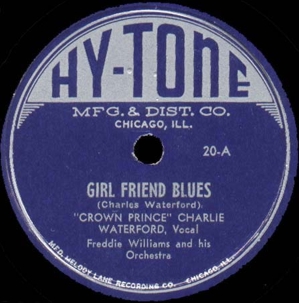
Charles Waterford (voc); with Freddie Williams (dir, eg); poss. Harry "Pee Wee" Jackson (tp); Nat Jones (as); unidentified (ts); unidentified (p); prob. Henry Fort (b); unidentified (d).
Chicago, prob. August 1946
| 20 A | Girl Friend Blues (Waterford) | Hy-Tone 20-A, Classics 5024 [CD] | |
| 20 B | Satisfied Blues (Waterford) | Hy-Tone 20-B, Classics 5024 [CD] | |
| 21A | |||
| 21B |
This classic blues shouter recorded his first sides as a leader in front of Freddie Williams' own orchestra. They were released on Hy-Tone 20. We have knowledge of just two sides from what we presume was a four-track session intended to lead to two releases. And there are no matrix numbers except 20 A and 20 B, which hampers efforts to identify the recording venue. The recording quality is not on a par with what we hear on the Bill Martin sessions (done at United Broadcasting) or with the Bing Williams sides (made at Myron Bachman's Studio, which also provided good-quality sonics for Marl Young's Sunbeam label). The Crown Prince Waterfords are shallower sounding and the pressing on the extant copies is far from perfect. However, the instrumental lineup is the same as on the Jo Jo Adams sessions earlier in the year and on the Bing Williams session that was made a little later. Freddie Wiliams wanted the same instrumentation for all of his studio bands.
Classics 5024, Crown Prince Waterford 1946-1950, is a reissue CD from 2001. We are indebted to Dave Penny's liner notes for some of the details on Waterford's career.
Discographers have bailed on this session in the past. We know that Freddie Williams didn't play tenor sax on the date, despite the attribution in Lord's Jazz Discography! Of course he was playing the guitar. We can also give identifications for the Hodges-style alto saxophonist, who plays the lead-in to "Girl Friend Blues," and, more tentatively, to the raspy, pitch-and-yaw trumpeter, who is responsible for the intro and some of the vocal accompaniment to "Satisfied Blues." The tenor saxophonist is confined to the horn section, which executes smoothly, as was the norm on Williams-led dates. The 78s that we have heard do the drummer no favors, but the pianist is out of the Teddy Williams lineage and the pulse is carried by Freddie Williams on guitar and a bassist who may be old reliable Henry Fort.
It's hard to date a record that carries only A and B designations, but the advertisement that Hy-Tone took out for it in early September suggests that it was made in August 1946 when Freddie Williams briefly returned to activity as a bandleader (see the Bing Williams session for more about this).
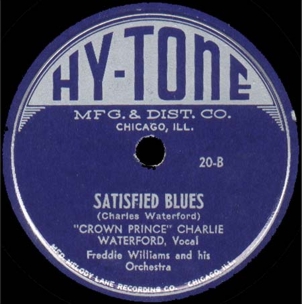
Charles "Crown Prince" Waterford was born in Jonesboro, Arkansas, on October 21, 1919. He first performed professionally with Andy Kirk and His Clouds of Joy, according to a King bio promo; the date (and the priority claim) need to be checked. He supposedly had auditioned for Kirk at Chicago's Savoy Ballroom. Tony Burke and Dave Penny in their article on him in Blues & Rhythm, April 1986, traced his career back to 1936, when he was a vocalist in Leslie Sheffield's Rhythmaires band, playing a long residency at the Ritz Ballroom in Oklahoma City. The rhythm section for that engagement consisted of no less than Charlie Christian (guitar), Abe Bolar (bass), and Nat "Monk" McFay (drums).
By the mid-1940s, Waterford was well established in Chicago clubs, but not yet equipped with his nickname. During March and April of 1944 he was playing at Square's Steak House (104 East 51st) on the same bill with the Buster Bennett Trio, and an apparent relation, Evanna Waterford Cotton. Then according to a Defender blurb he started a long engagement at the Cotton Club (late July to November) following "a conquest of exclusive spots in the Loop" (meaning white venues). A blurb from the July 29 Defender noted that Waterford "is one of the reigning artists on NBC and a favorite in Chicago." Briefly in September 1944 he sang at the prestigious Club DeLisa.
In early 1945, Waterford moved to Los Angeles and was soon performing there with the great Jay McShann aggregation, which needed a replacement for Walter Brown. He composed and recorded three titles with the band, including "Garfield Avenue Blues," a paean to his old haunts in Chicago, and "Crown Prince Boogie," the song that gave him his lifetime moniker.
Waterford, however, had to share vocal honors in the band with another great talent, Jimmy Witherspoon, and by 1946 there was apparently no room for him. So he was back in Chicago, ready for Williams to put him on record as a solo artist.
Williams and Rothner must have been fairly high on the record, as they took out a large ad in the September 7, 1946 Chicago Defender touting the Waterford platter, as well as the first two Jo Jo Adams releases and the first Memphis Slim release.
Waterford in October was playing the New Club Alice (422 1/2 East 47th) under the billing of "Charles (Crown Prince) Waterford." No mention was made of his Hy-Tone record.
In 1947, Waterford was again in Los Angeles, recording in March for the Aladdin label (with the Gerald Wilson band) and in November for Capitol (with the Maxwell Davis band). Other recordings in LA followed for Torch and King during 1949. He went to Cincinnati to record some excellent material for King in March 1950, but thereafter his recording career became intermittent, for such small imprints as Excello (1955), Orbit (1959 and 1962—the latter material was attributed to "Crown Prince Waterford and his Twistologists"), and Stampede (1965). Left behind by the trends in popular music, he entered the church and became the Reverend Solomon Charles Waterford. Charles Waterford died on February 1, 2007.
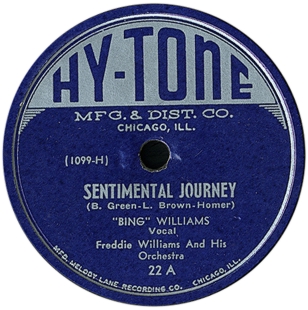
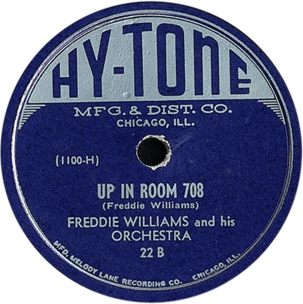
Leroy "Bing" Williams (voc) with Freddie Williams & His Orchestra: Freddie Williams (eg, ldr); poss. Harry "Pee Wee" Jackson (tp); Nat Jones (as); prob. Moses Gant (ts); unidentified (p); prob. Henry Fort (b); unidentified (d).
Bachman Studio, Chicago, July 1946
| 1099-H | Sentimental Journey (B. Green-L. Brown-Homer) | Hy-Tone 22 A | |
| 1100-H | Up in Room 708 (Williams)* | Hy-Tone 22 B | |
| 1101-H | We're Together Again (Rabon Tarrant) | Hy-Tone 23 A | |
| 1102-H | Nat's Blues (Williams) | Hy-Tone 23 B |
Although Hy-Tone had employed matrix numbers in an 1100 series before, the numbers here are from the same series as was used for three sessions on Marl Young's Sunbeam label in August and September of 1946. Miracle (in its very early stages, June 1946), and Gold Seal in August and September 1946. Rondo also made recordings in this series between June and October 1946. Some comments by pianist Max Miller, who used Myron Bachman's Studio on Carmen Avenue for many of his own recording sessions, and was affiliated with Gold Seal around this time, have led us to believe that the 1000 matrix series originated there. John Steiner also used Bachman Studio during this period.
It looks as though this session immediately followed one by organist Marsh McCurdy and pianist Bob Peary for Rondo (July 1946, which included matrix 1097), and preceded sessions for Rondo by pianist Jimmy Blade (matrix numbers 1103-1106) and organist Elmer Ihrke (including matrix 1107), both done in August.
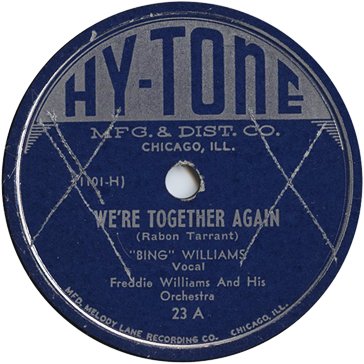
One reason for his presence on this session is that Freddie Williams, after some years of inactivity as a leader, was about to take a band into the Grand Terrace Ballroom. He posted an "indefinite" contract with Musicians Union Local 208 on September 5. Williams saw an opportunity to get back to work as a musician; if so it was short-lived, as the Terrace was known for fitful attempts at revival. The ballroom's management would continue off and on with these fizzlers until 1957, enlisting in their lost cause such leaders as King Kolax (1955 and 1956), Sun Ra (1955), Elmore James (1956), and even former Hy-Tone artist Bill Martin (1957).
Hy-Tone 22, an item previously unknown to discography, surfaced in August 2002 at a Joel Slotnikoff auction. Copies of the better known Hy-Tone 23 are in the collections of Mike Kredinac and Robert Campbell. The title "Nat's Blues" makes it pretty obvious that the featured alto saxophonist is Nat Jones, one of Freddie Williams' favorite musicians. The string bass player, who was recorded unusually well on this session, sounds like Henry Fort from the two Bill Martin outings.
Leroy "Bing" Williams was a featured performer at the Club DeLisa in March 1942, according to coverage in the Defender. His specialty at the time was "popular song hits." In a caption on a photo of Williams singing at the Club DeLisa, the December 5, 1942 Defendersaid he was "so nicknamed, because he croons like Bing Crosby." In March 1945, Bing Williams was out on the West Coast, singing and acting as MC for a big band led by Johnny Otis. According to a review in Billboard of the show at Club Alabam, on Central Avenue in Los Angeles, "Williams warbles two tunes. His better one is What a Difference a Day Makes. Voice is good and he does well by sticking to ballads" (review by Sam Abbott, March 24, 1945, p. 26).
If the August or September date is correct, the Bing Williams session would be the last one on which Freddie Williams assembled and directed the band. It is a Swing outing; on "Up in Room 708" there are exuberant solos from the raspy trumpet player, the eloquent Swing tenorist (who sounds like Moses Gant to us), and Nat Jones, as well as something in the Clyde Hart mold from the pianist.
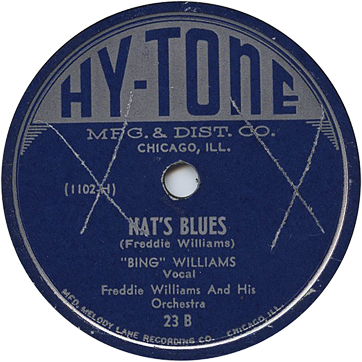
"Sentimental Journey" is set up like a jazz record, allocating just one full chorus to Bing Williams' baritone crooning so the band gets more space (including a guitar intro by the session director). It is a remake of the big band ballad that was popular in 1945 in versions by Les Brown and Hal McIntyre. Bing Williams has a drippier baritone instrument than his namesake, but makes a decent account of himself. His version of "Sentimental Journey" is a reminder that not all Black music in the 1940s was blues or jazz, that there was a great appreciation for classic Tin Pan Alley pop songs—and that Bing Crosby was an idol in the Black community. "We're Together Again" is a pretty decent ballad sung in the same ripe baritone, and "Nat's Blues" features a couple of acceptable blues choruses from Mr. Bing.
Freddie Williams continued to supervise the sessions through the end of the year; for instance, we may reasonably assume that it was he who recruited Nat Jones to appear on the Floyd Smith session.
Bing Williams was still active in 1949, when he was tapped to open the new Ebony Lounge in Cleveland. Featured alongside singer Rita Butler and the band of Morris Turney, he was said to have performed with Lionel Hampton, Duke Ellington, Benny Carter and Lucky Millinder (John Fuster, "About the Stars," Clevleand Call and Post, February 26, 1949, p. 9B. We lose sight of Bing Williams after that.
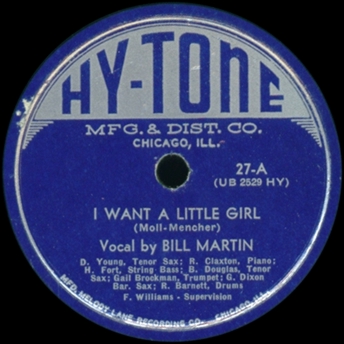
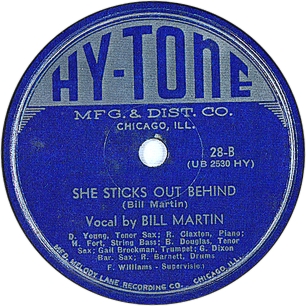
Bill Martin (voc); Gail Brockman (tp); Dave Young (ts); Buck Douglas (ts); George Dixon (bars); Rozelle Claxton (p); Henry Fort (b); Richard Barnett (d); Freddie Williams (supervision).
United Broadcasting Studios, Chicago, c. September 1946
| UB 2529 HY | I Want a Little Girl (Moll-Mencher) | Hy-Tone 27-A | |
| UB 2530 HY 28B | She Sticks Out Behind (Martin) | Hy-Tone 28-B | |
| UB 2531 HY 28A | "Mariah" (Martin) | Hy-Tone 28-A | |
| UB 2532 HY | Tall Brown Woman (Martin) | Hy-Tone 27-B |
As with Martin's first session, personnel are from the labels, first names filled in from other sources. On the second session, bebopper Gail Brockman replaced Paul King on trumpet. (Since Buster Bennett later got into a beef with King, who had done some arranging for Buster's record date of September 30, then taken off to New Orleans and missed the session, our estimated September date fits for more than one reason.) Brockman had been a member of Earl Hines' rebellious band of 1942, alongside Charlie Parker and Dizzy Gillespie; in 1946, Brockman was a member of Gene Wright's Dukes of Swing.
Two sides—the standard "I Want a Little Girl" and Martin's "Tall Brown Woman"—were paired on Hy-Tone 27. Bill Martin turns in an excellent performance on the ballad, which discographies formerly abbreviated to "I Want a Girl."
Hy-Tone 28 paired the other two tunes, "Mariah" and "She Sticks Out Behind." "Mariah" is mainly about Martin's uptown blues vocalizing; the band provides smooth R&B backgrounds. On "Sticks Out," Claxton gets a piano intro, Martin concentrates on the blues singing again, and Buck Douglas gets the 2-chorus tenor solo; an unidentified band member shouts "Hey there, Bill!" before the punch line. Our thanks to Mike Kredinac for a dub of Hy-Tone 28.
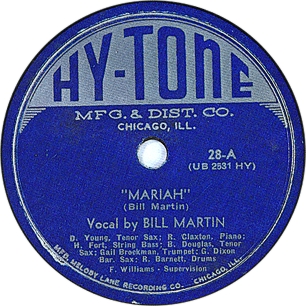
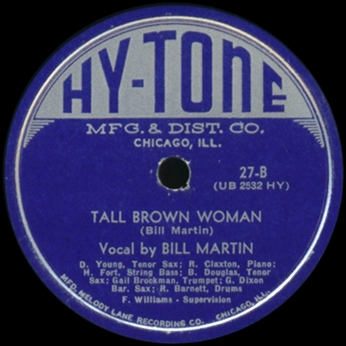
According to Tom Lord's Jazz Discography, a group under Hillard Brown's leadership (almost certainly his current band from Joe's Deluxe Club) recorded for Columbia in Chicago at an unspecified date. The four items were: CCO 4595, Cold Feet Blues; CCO 4596, Alley Cat Woman; CCO 4597, Rouse Your Window High; and CCO 4598, She Sticks Way Out Blues. Lord gives the "probable" personnel as Bill Martin (trumpet and vocals), Moses Gant (tenor sax), Dave Harris (alto sax and clarinet), Pete Hatch (piano), Adolphus Dean (bass), and Hillard Brown (drums). Since these Columbia matrix numbers follow the Bill Crosby date of July 29, 1946 and almost immediately precede the Jump Jackson session of September 13, 1946 (see our Sax Mallard page for more about both of these), we can fill in the date as August or early September 1946. According to Lord, nothing from the session was ever released. The titles tell us that Bill Martin's vocals were featured. Columbia's management may have decided to leave it all on the shelf when Hy-Tone released "She Sticks out Behind"—obviously the same song as CCO 4598.
Bill Martin appears as the leader of the band at Joe's Deluxe Club in July 1947 (his "indefinite" contract with the nightery was accepted and filed by Local 208 on July 3.) From 1947 through 1950, the former Hillard Brown aggregation continued to hold down the position as the house band for Joe's Deluxe Club (6323 South Parkway), and the ads usually billed them as "Bill Martin, His Trumpet and Band." Founded by Joe Hughes in 1938, the club was something of an institution on the city's South Side where patrons could see an elaborate floor show presented by Valda Gray's female impersonator revue.
On December 26, 1947, Martin's band backed Dwight "Gatemouth" Moore on a marathon session for King Records, which was stocking up in anticipation of the recording ban. The lineup was Martin, trumpet; Bert Patrick, alto sax; Moses Gant, tenor sax; Nat Walker and Simeon Hatch taking turns at the piano bench; Dolphus Dean, bass; and Jimmy Adams, drums. No fewer than 20 sides were recorded. Just 4 appeared on King singles during 1948. That proved to be the end of the road. Moore put a crimp on all prospective sales when he announced from the stage at the Club DeLisa that he was leaving secular music.
"Hey, Mr. Gatemouth" from the session was used on King 4211-A, credited to Walker-Martin-Moore. "Gotta Walk" on King 4224-B was credited to Senabelle Fenner (4224 was released in May 1948). King 4256, the last before Moore underwent his conversion, came out in December 1948 and used two sides from 12 months earlier. "You're My Specialty Baby" by Sennabelle Fenner was 4256-B. 4256-A was "Something I'm Gonna' Be [sic]," with composer credit to Jack Cooley. We'll be seeing more of that particular number.
Another 6 sides from the marathon were tapped for a King LP in the 1950s; 9 more were first heard on a Westside CD in 2000; one has been lost. The Gatemouth Moore session is the most extensive recorded evidence we have of a Bill Martin band at work. Martin is not the vocalist, so we get to hear lots of his trumpet. Except … the very last number from the outing, "Lucinda," is credited to Martin, is a paraphrase of "Mariah," and includes no trumpet past the introduction—because Martin was singing it.
Bill Martin's band was apparently given time each evening between the impersonator performances to do their own material. In a December 4, 1948, Chicago Defender blurb under a photo of the Bill Martin aggregation, the band was billed as "Bill Martin and his Hy-Tones Orchestra," and members listed besides Martin were Adolphus Dean (bass), Jimmy Adams (drums), Moses Gant (tenor sax), Pete Hatch (piano), and Bert Patrick (sax). The band was reported as wowing the patrons of Joe's Deluxe Club with "their recent recording numbers." A writeup from 1949 said of the club, "the spot offers swing tunes by Bill Martin and his fine small outfit, recent importations from the juke box field." Joe's Deluxe Club continued with the revue until it folded in the summer of 1950.
Martin recorded just one other time, when his orchestra laid down four tracks for Decca subsidiary Coral on September 22, 1950. Or maybe that was September 2? Billboard announced on September 9 that "Bill Martin cut four r. and b. sides for Coral last week" (p. 21). Coral 65041 was reviewed in Cash Box on November 25, 1950 (p. 18). One of the titles was "Hey Lucinda," which Martin, of course, sang; the other was "Evenin'," vocal by Mary Reed. Bill Martin's Coral sides are not exactly abundant today, so we have nothing further to report.
During 1951, Martin gigged as a member of other outfits. On January 19, 1952, the Flame Lounge had Tom Archia and his All-Star Combo with Bill Martin, Pete Hatch (piano), Lowell Pointer (bass), and Buddy Smith (drums). However, Martin was back once more as the leader at Joe's Deluxe Club for a time (contract accepted and filed by Local 208 on June 19, 1952; the contract was renewed on December 4). Charles Walton recalls that in the early 1950s Martin went on the road for a while as leader of a band in a black carnival, called the Claxton Revue. In October 1954, Martin resurfaced as the leader at the Leather Glove (indefinite contract accepted and filed on October 7). On June 1, 1955, Willie Mabon cut "Lucinda" for Chess. The song was credited to Bill Martin; it's a reasonable inference that Martin was the trumpet player on the date, which also produced "The Seventh Son."
A Chicago Defender ad for Tony's House of Joy (August 24, 1957) promoted a Gala Labor Day Party and Dollar Party, coming up on September 2. Top billing went to Bill Martin's Band starring Tom Archia, which was also appearing at the Grand Terrace during its very last attempt at a revival. Helen Calloway (vocals) was also mentioned. Martin was still on the scene in 1961, by which time he had gravitated to Dixieland bands (he was slated to appear on a Junie C. Cobb record session that year with Red Saunders, though Fip Ricard had to replace him at the last minute). Bill Martin died in Chicago on September 16, 1972. At the time of his death he was working as a janitor for the Chicago Board of Education.
Basic facts on Bill Martin came from the death certificate and the application for death donation in the Bill Martin file in the Musicians Union Death File collection at the Chicago Public Library.
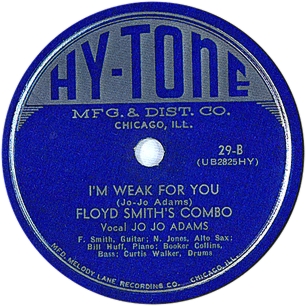
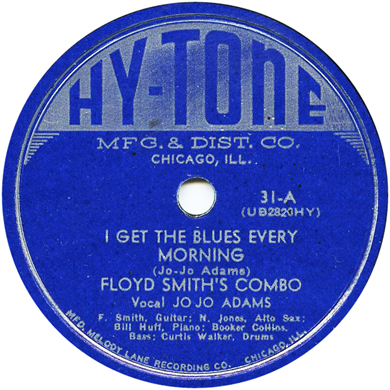
Jo Jo Adams (voc); Nat Jones (as); Bill Huff (p); Floyd Smith (eg); Booker Collins (b); Curtis "Geronimo" Walker (d).
United Broadcasting Studios, Chicago, c. December 1946
| UB2825 HY 29B | I'm Weak For You^ (Adams) | Hy-Tone 29 B, Classics 5083 [CD] | |
| UB2826HY | I Get the Blues Every Morning^ (Adams) | Hy-Tone 31-A, Classics 5083 [CD] | |
| UB2827HY | Around the Watch Part 1 (Adams) | Hy-Tone 30 A, Classics 5083 [CD] | |
| UB2828HY | Around the Watch Part 2 (Adams) | Hy-Tone 30 B, Classics 5083 [CD] | |
| UB2829-HY 29A | Floyd's Guitar Blues^ (Smith) | Hy-Tone 29 A, Classics 5083 [CD] | |
| UB2830HY | Voodit^ (Adams) | Hy-Tone 31-B, Classics 5083 [CD] |
Leadbitter, Fancourt, and Pelletier list this session as being recorded in 1949; Tom Lord more plausibly has 1946 for the numbers under Jo Jo Adams' name—then reverts to 1949 for the titles under Floyd Smith's name! The United Broadcasting Studio matrix numbers, assuming that the transition from UB2999 to UB21000 took place around the beginning of 1947, locate the session toward the end of 1946; early December is most likely because Floyd Smith's move out of the Andy Kirk Orchestra took place then. We confirmed the matrix numbers and label copy of Hy-Tone 29 from copies in the collections of Tom Kelly and Dan Kochakian. On the label the Hy-Tone 29 matrix numbers read UB2825HY and UB2829HY.
All six released sides from this session were reissued for the very first time in January 2004 on Classics 5083, The Chronological Jo-Jo Adams 1946-1953. This CD assembles all of Jo Jo's released sides except the six he made with Tom Archia.
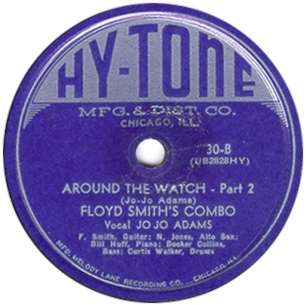
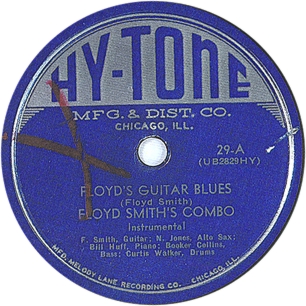
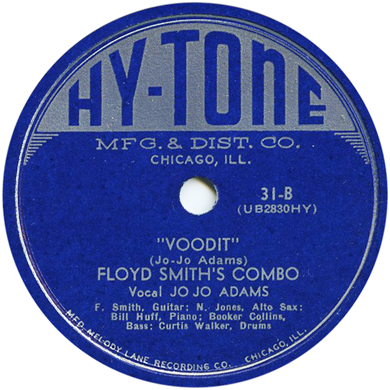
Jo Jo Adams (already the subject of a Melody Lane session) sang on five of the six tracks that were released. (The session might have been set for eight tracks, but if that was the plan we have no firm evidence of the lastl two.) Adams had been in Los Angeles in the summer of 1946, performing at Club Hideaway with Clifford Scott; he had also cut six sides for Aladdin in June, which benefited from an excellent band led by Maxwell Davis.
The first single (Hy-Tone 29) from the December session featured "I'm Weak For You" with the flip attributed just to Floyd Smith's Combo, a remake of his signature number "Floyd's Guitar Blues." This was obviously a set piece; the guitar part is note-for-note identical to what we can hear on Smith's 1939 recording. The session produced two more Adams releases, the two-part "Around the Watch" (Hy-Tone 30), and "I Get the Blues Every Morning" b/w "Voodit" (Hy-Tone 31). "Around the Watch" is one of many versions of "Around the Clock Blues" to be waxed in 1945-1946. On Jo Jo's rendition, Side 1 takes the singer and his lady from midnight to 7am; their travails from 8am to 12 noon occupy Side 2. All that "rollin'" finally takes its toll; the final chorus breaks off in the middle on the words, "I'm soft," leaving the band to finish out the 12 bars. Known for raunch on the bandstand, Jo Jo leaves little to the imagination here.
From March 14 through May 18, 1947, Jo Jo Adams was in the show at the Club DeLisa, which was backed by Fletcher Henderson's last big band. He made a session with Tom Archia for Aristocrat in August 1947, which included Floyd Smith's uncredited presence on guitar. He also appeared at some of the Sunday matinee dances and battles of the saxes that McKie Fitzhugh was putting on at the Pershing Ballroom (his peformance on another two-parter called "Cabbage Head" was taped by Al Benson at some point in the spring of 1948 and later released on Aristocrat.). After a four-year hiatus, he recorded two blistering performances for Chance in 1952 with Melvin Moore's house combo from the Flame Lounge and two solid blues for Parrot in 1953 (with a Red Saunders group using wild Sun Ra arrangements). Thereafter he left the recording scene, though he continued to work the clubs as singer and MC into the 1960s. Jo Jo Adams died on February 27, 1988.
Guitarist Floyd Smith was born in St. Louis, on January 25, 1917. Originally a banjoist, he became one of the earliest adopters of the electric guitar and was influenced by Django Reinhardt. He first recorded with the Jeter-Pillars Orchestra in 1937. In 1937 the first electric guitar, the Gibson ES-150, became widely available; Eddie Durham took up the instrument and in turn converted Smith and Charlie Christian. Smith's reputation was made by his debut session with Andy Kirk and His Clouds of Joy, on March 16, 1939. This produced his Decca recording of "Floyd's Guitar Blues" (1939), which exhibited slide playing on the Gibson ES-150 electric guitar (Did he set the guitar on his lap? The same manner of production can be heard on his Hy-Tone remake). Smith continued to work and record regularly with Andy Kirk until the recording ban hit in July 1942. He served in the army during World War II, participating in the D-Day landings and, under less harrowing circumstances, jamming with Django Reinhardt in Paris. On finishing his military service in 1945 he returned to Kirk's band, cutting four more sessions with them between November 27, 1945 and December 2, 1946. He arrived in Chicago with Andy Kirk and His Clouds of Joy in August 1946 (ads ran in the Chicago Defender for Kirk at the Pershing Ballroom on August 29, and for Kirk's "2nd Smash week" at the Band Box. Both prominently mentioned Smith). His bassist Booker Collins was a former long-time member of the Kirk band.
The Hy-Tone labels give the rest of the personnel as Nat Jones on alto sax, Bill Huff on piano, Booker Collins on bass, and Curtis "Geronimo" Walker on drums. It appears that this band was assembled soon after Smith returned to Chicago from his last session with Kirk, which took place in New York City.
Unusually for the company's releases, Hy-Tone 29 got a review in Billboard, which appeared on April 12, 1947:
Ex-Andy Kirk git-star, Floyd Smith, fronts a five-piecer here, highlighting his own fine single string and chord amplified work. First side is a remake, only with a small combo, of his Decca sepia series hit. Side shows that Smith's long service stint didn't dull his technique and he offers some of the finest simulations of a doleful human voice on record. Reverse is a stereotype blues, that picks up plenty to commend it from the vigorous throating of Jo-Jo Adams. Adams is one of those firey vibratto [sic] singers of the Eddie Vinson school, who always wins race interest. Race taprooms will want either side on their boxes.
Our thanks to Bo Sandell for pointing us to this review.
Smith would enjoy a long residency at the famed DuSable Circular Bar and Lounge (764 Oakwood Boulevard) as "Floyd Smith and his Swing Trio." (The gig started on December 7, 1946—Smith recalled opening on Pearl Harbor Day—and was first advertised in the Defender for December 14. Smith's indefinite contract with the lounge was accepted and filed by Musicians Union Local 208 on December 19, 1946.) Jazz deejay Holmes "Daddy-O" Daylie, when interviewed by Dempsey J. Travis for his Autobiography of Black Jazz, described seeing Smith at the DuSable Lounge, and related that "Floyd Smith and his trio were famous at that time. He had written 'Floyd's Guitar Blues' when he was with the Andy Kirk Band." In 1947, Smith participated in a Jo Jo Adams date for Aristocrat. A helpful story in the March 26, 1949 Defender, "Floyd Smith's Trio: It's Still Stretching It" carried the following lead: "Ever hear of a group that came to a spot to play a two weeker and wind up playing 27 months." Bill Huff and Booker Collins were still in the trio. The story mentioned recordings with Jo Jo Adams (obviously the Hy-Tone session) and with the Harmonicats (we aren't sure when Smith guested with them—perhaps when they were recording for Bill Putnam's Universal label in 1947 and 1948). Smith had also made a guest appearance with the Earl Hines Swingtette for MGM (December 1948). He would go on to cut a session with the Dizzy Gillespie Big Band for Capitol (January 1950).
Smith recorded for Lyric in 1949 with Bill Huff and Booker Collins (a photo of him at the recording session was published in Down Beat), but there is no confirmation that any sides were released. One wonders whether this material came from a freelance session that he cut for songwriter and entrepreneur John E. Coppage at United Broadcasting Studio on May 20, 1949 (listed, unusually, among the contracts in the Local 208 Board Meeting Minutes because the contract was with Coppage, for the session only, and not with a record company). Smith returned to UBS with his long-standing trio to cut another session for Coppage on June 8, 1949; this one we can trace because Coppage later sold two sides to Aristocrat which first released them in February 1950 as one of two [!] Aristocrat 409s. The sides were reissued on Chess 1439 in November 1950 after the label had changed names. The Chess release got enough airplay that Smith found out about it and brought a claim against Coppage and United Broadcasting Studios, who had never bothered to pay him for the session on June 8, 1949; the complaint was heard by the Board of Musicians Union Local 208 on November 16, 1950.
Smith went on to make four sessions in Chicago for his old label, Decca, as a member of a band led by Horace Henderson. On October 9, 1951, Henderson's outfit (Gail Brockman, trumpet; Walter Leonard, tenor and baritone saxes; Porter Kilbert and Riley Hampton, alto saxes; Arthur Edwards, bass; George Reed, drums), cut two instrumentals and accompanied Little Donna Hightower, then breaking in as a singer, on two sides. "I Ain't in the Mood," Hightower's "answer record" aimed at John Lee Hooker's hit "I'm in the Mood," featured Smith's wild and crazy slide guitar. On October 10, Decca brought the band (minus Kilbert and Hampton on this occasion) back to record two numbers aimed at the R&B market. On "Hot Rock" and "Lido Walk" Leonard's tenor sax and Smith's guitar were featured. Another two numbers featured Smith's singing. On February 3, 1952, Hightower cut two additional sides with the Henderson band. In April 2, Hightower returned to the studio to do five more, of which four were released. The second release from the April session, on Decca 48299, was reviewed in Billboard on July 18, 1953 (p. 36). Smith's slide playing was featured again on "You Had Better Change Your Ways" and he makes an important contribution to "Kiss Me Baby," though Porter Kilbert takes the solo honors on that one. Four further numbers featured Smith's own singing. The last of these to be issued, "Don't Cry, Baby," appeared on the B side of Decca 28801 in September 1953, with an A side by the Billy Valentine Trio with Mickey Baker on guitar; the Billboard reviewer used such words as "okay" and "routine," but did mention the Horace Henderson presence (September 12, 1953, p. 41). None of these Decca releases are terribly common today, and most of the copies for sale are DJ specials, suggesting a distinct lack of oomph commercially.
Smith then joined Tom Archia and Bill Martin at the Flame Lounge for a while. He appears to have done a little session work for Parrot in 1953, again behind Jo Jo Adams on the singer's final record date (which also featured arrangements by Sun Ra). From 1953 through 1957 Smith toured and recorded as a member of Wild Bill Davis's highly successful organ trio (Chris Columbus was the drummer). After an obscure session for Mark in 1956, he made an valedictory LP in France for Black & Blue in 1972, with Will Bill Davis on organ. Smith died in Indianapolis on March 29, 1982.
For much more information on Floyd Smith, see Charles Walton's lengthy interview with him from 1981 on the Jazz Institute of Chicago website.
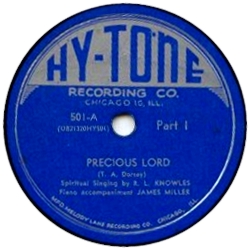
As the Hy-Tone operation approached the end of its first year in the business, Freddie Williams began to scale back his participation. He had stopped assembling studio bands, and his gig at the Grand Terrace seems to have been his last fling at working the clubs. From here on out, he would no longer be credited with supervising the sessions. Rothner recalls, "Freddie Williams drifted away from the company after a while, and it became mine really." So Rothner had to take over responsibility for signing and recording the artists. Regarding R. L. Knowles, Rothner told Pruter, "I heard him singing one of his spirituals and I thought it was great. So we decided to record him." It didn't hurt that with just Knowles and his keyboard accompanist, James Miller, the session costs were lower.
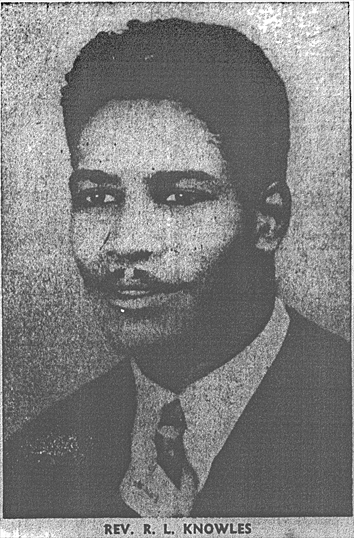
According to gospel expert Anthony Heilbut, R. L. Knowles came from Kansas City and built his reputation as the lead singer in Reverend Clarence Cobb's First Church of Deliverance Radio Choir. The California Death Index says that Robert L. Knowles was born in Oklahoma on September 16, 1915 (the Social Security Death Index gives his birth year as the less plausible 1920). According to Bob Marovich, Knowles was brought from the Metropolitan Spiritual Church in Kansas City to organize and direct the choir at the First Church of Deliverance. The Cobb church was one of the most prestigious in Chicago's black community. By 1944, Knowles had become prominent enough to put together a major gospel event. The Defender ran his photo with an advertisement for a "Pre-Thanksgiving Service" that he was conducting:
Let us come together and thank God for his choicest blessings this Tuesday night, Nov. 21st, at 8 P.M. at Du Sable High School, 49th and State Sts. Hear these artists in a grand program. Myrtle Jackson, Erma Gwynn, Robert Anderson and group, Amelia Anderson, Cleo Carson and many others. All are welcome to come and receive their blessings.
When Robert Anderson, who was duly featured in that 1944 concert, left the Roberta Martin Singers in 1939, he first began singing duets with Knowles. The two, said Heilbut, should be "credited with bringing the 'ad-lib' style to church singing: the jazz-influenced runs, the free-spirited melisma, the frank acknowledgement of secular music..." It is no wonder that Nathan Rothner chose to record Knowles.
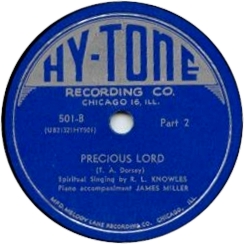
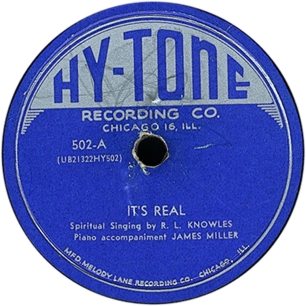
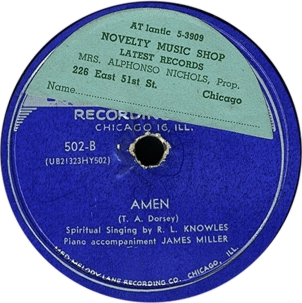
R. L. Knowles (voc); James Miller (p).
United Broadcasting Studios, Chicago, c. June 1947
| UB21320HY501 | Precious Lord, Pt. I (Thomas A. Dorsey) | Hy-Tone 501-A | |
| UB21321HY501 | Precious Lord, Pt. 2 (Thomas A. Dorsey) | Hy-Tone 501-B | |
| UB21322HY502 | It's Real (composer unidentified) | Hy-Tone 502-A | |
| UB21323HY502 | Amen (Thomas A. Dorsey) | Hy-Tone 502-B | |
| UB 21324HY503 | Lord, I Want to Rest (James Sands) | Hy-Tone 503-A | |
| UB 21325HY503 | Lord, I've Tried (Rev. W. H. Brewster) | Hy-Tone 503-B |
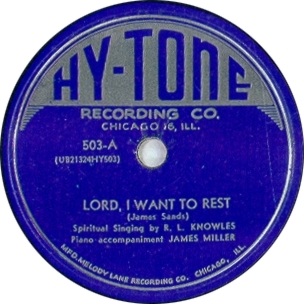
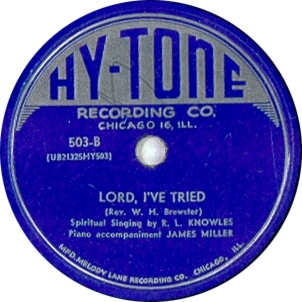
After the Floyd Smith/ Jo Jo Adams outing, Hy-Tone undertook no recording for six months. When it resumed, Freddie Williams had cut back his involvement. It was around June of 1947 that Nathan Rothner supervised his first session, which produced six sides on R. L. Knowles, accompanied by keyboard player James Miller.
As so often happens with the small independent labels, the most poorly documented aspect of Hy-Tone has been its gospel series. Galen Gart gave circa 1948 as the date for a release number 507 (one, it so happens, that we haven't found). Blues Research mentioned only 501 and 502, from Knowles' first session for the label. Bill Daniels initially alerted us to the existence of Knowles on Hy-Tone 503, also from this first session. Hy-Tone 500, 504, and 505, which came from Knowles' second and third sessions, were rediscovered only during the past decade. And whether there was a 506 or a 507 still remains to be determined.
On Hy-Tone 502, Knowles sings in a trained baritone voice. "It's Real" is a rather schmaltzy composition; "Amen," another composition by the great Thomas A. Dorsey, gives Knowles an opportunity to become passionate. We would like to hear what Knowles could do with "Precious Lord," which he extended over both sides of Hy-Tone 501.
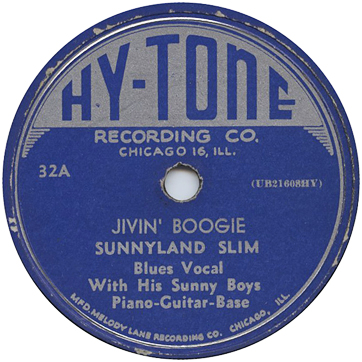
Nathan Rothner also took the lead in recording Sunnyland Slim, who quite possibly made his first 78s as a leader for Hy-Tone (running neck-and-neck with another small independent called Aristocrat). "I had a lot of high hopes for him, we paid for the session, but could not sell anything." Again, 6 tunes were laid down at the first session.
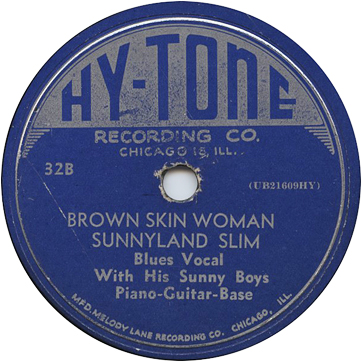
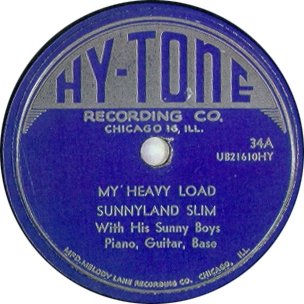
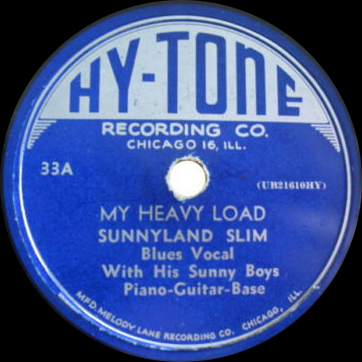
Sunnyland Slim (voc, p); Lonnie Johnson (eg); Andrew Harris (b).
United Broadcasting Studio, Chicago, late August or early September 1947
| UB21608HY | Jivin' Boogie | Hy-Tone 32A, Official [Dan] 6043, Classics 5013 [CD] | |
| UB21609HY | Brown Skin Woman | Hy-Tone 32B, Chicago CH-LP 212, Official [Dan] 6043, Classics 5013 [CD] | |
| UB21610HY | My Heavy Load | Hy-Tone 33A [misnumbered], Hy-Tone 34A, Official [Dan] 6043, Opal OCD 110, Classics 5013 [CD] | |
| UB21611HY | Keep Your Hands out of My Money | Hy-Tone 33B [misnumbered], Hy-Tone 34B, Official [Dan] 6043, Opal OCD 110, Classics 5013 [CD] | |
| UB 21612; UB21612HY on label | The Devil Is a Busy Man | Hy-Tone 33B [unrenumbered] | |
| UB 21613; UB21612HY [sic] on label | Miss Bessie Mae | Hy-Tone 33A [unrenumbered] |
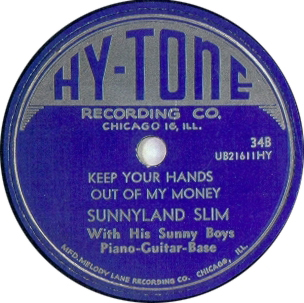
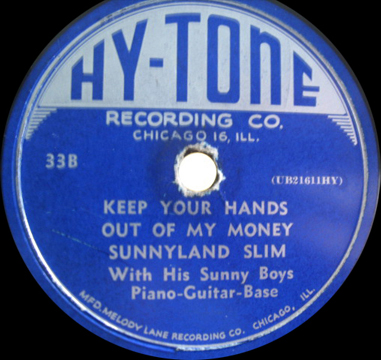
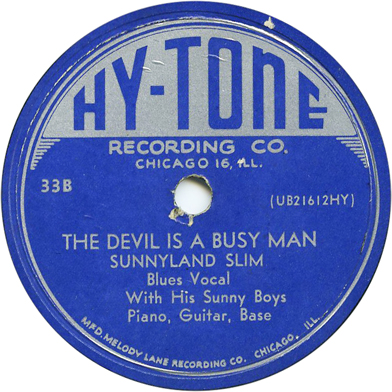
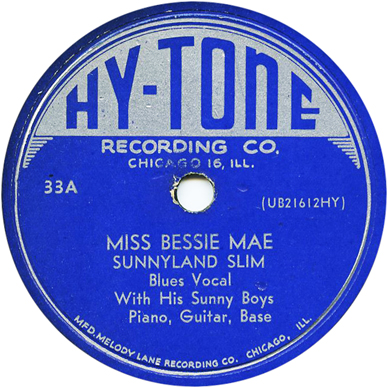
Slim had previously appeared as a vocalist on a marathon session for Specialty in September 1946, under the general leadership of Jump Jackson; see our Sax Mallard page for that one. He had not previously recorded as a leader, however; either Nathan Rothner or Sammy Goldberg was the first to bring him into the studio for a session of his own.
Sunnyland Slim worked with a lot of noteworthy guitarists during his career: Muddy Waters, Robert Jr. Lockwood, J. B. Lenoir, Floyd Jones, Lefty Bates... His only recorded collaboration with Lonnie Johnson took place on this session. "Jivin' Boogie" is unusual both in its reliance on a boogie bass and in the amount of space Sunnyland leaves for the guitarist. On "Brown Skin Woman" we can hear one of the earliest examples of the trademark Sunnyland sound. "My Heavy Load" is a feature for Johnson's guitar—working the South Side clubs in the summer of 1947, he was a pretty deluxe musician for a little company like Hy-Tone.
Sunnyland Slim was born Albert Luandrew in Vance, Mississippi, September 5, 1906 (most sources say 1907, but the Social Security Death Index and 1920 census data agree on 1906). He was the son of Tom and Mary Luandrew (spelled "Loeandrew" by the census taker, but not in other documents that we have seen). We do not know exactly when Slim arrived in Chicago. He was playing semi-regularly at the Flame Lounge on 39th Street when he went into the studio for Hy-Tone.
From his first Hy-Tone session we have on record a total of six sides recorded by "Sunnyland Slim with His Sunny Boys." LFP note that two Hy-Tone 33s were issued in error. We have confirmed that some copies of Hy-Tone 33 were actually Hy-Tone 34, mislabeled: a copy of "My Heavy Load" b/w "Keep Your Hands of out My Money" with the familiar matrix numbers—and release numbers 33A and 33B—was offered for sale on ebay in November 2011 (our thanks to Tyrone Settlemier for alerting us to this item). Tom Kelly owns a copy of Hy-Tone 34. Lord's Jazz Discography has the bassist's name for this session as "Andrew Hare."

The most notable song of the six sides was "Brown Skin Woman," which must have sold a few copies upon its release in March of 1948 (Billboard ran an ad for the single on February 28 and covered its release on March 13), because in later years Slim would record the song many more times . The Boulevard Lounge in its Chicago Defender ad for October 9, 1948, billed his act as "Sonny Land Slim and his Recording Combo" and noted that it would be "playing his latest recording BROWN SKIN WOMAN." The Boulevard ad also indicates that Hy-Tone records could still be bought in stores at the time.
Both sides of Hy-Tone 34 were reissued in 1995 on the Sunnyland Slim CD collection Patriarch of the Blues 1947-1952 (Opal OCD 110). Hy-Tone 32 and 34 were reissued in 2001 on Classics 5013, Sunnyland Slim 1947-1948. The nonduplicated issue of Hy-Tone 33 (with "The Devil Is a Busy Man" and "Miss Bessie Mae") is so rare that Classics could not obtain a copy for its reissue package. Fortunately, it isn't lost; copies have been located by George Paulus and Robert L. Campbell.
Around the same time as this session, Sammy Goldberg at Aristocrat, would pair Slim up with Muddy Waters. Aristocrat brought him back for a followup session in December (the second session has become much more famous for Muddy's breakout single "I Can't Be Satisfied" than for any of Sunnyland's contributions). Sunnyland also cut two sessions for Victor in December, under the pseudonym of "Doctor Clayton's Buddy"; the label wanted to keep selling some records based on the fame of their blues recording artist Doctor Clayton, who had died in early 1947. The Victor sessions used him strictly as a singer, entrusting the piano chores to the more urban-styled Blind John Davis.
A second R. L. Knowles session initially came to our attention because the pianist (who, unlike many of his fellow gospel accompanists, had already joined the Musicians Union) filed a claim for overtime pay with the Local 208. We actually knew of its existence before we had seen any of the releases from it. The two Christmas carols remained unknown to us until March 2012, when a copy of Hy-Tone 500 came up for sale on ebay.
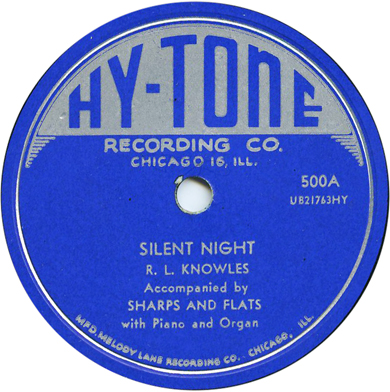
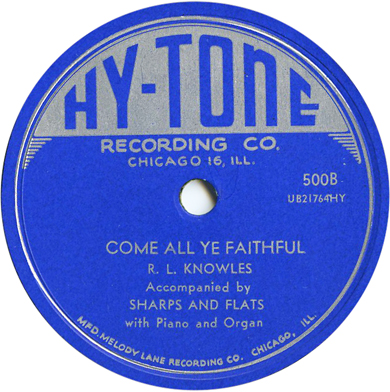
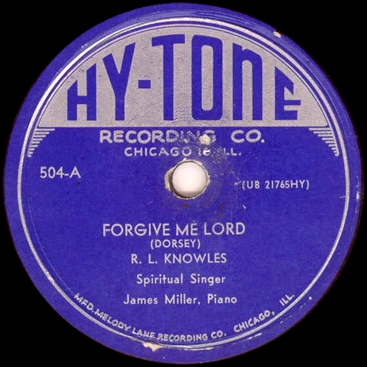
R. L. Knowles (voc); James Miller (org -1, 3; p - 2, 3); The Sharps and Flats: unidentifed choir -1.
United Broadcasting Studios, Chicago, October 13, 1947
| UB21763HY | Come All Ye Faithful% -1 | Hy-Tone 500-B | |
| UB21764HY | Silent Night% -1 | Hy-Tone 500-A | |
| UB21765HY | Forgive Me Lord (Dorsey) -2 | Hy-Tone 504-A | |
| UB21766HY | Live the Life I Sing -2 | Hy-Tone 504-B | |
| UB21767HY | I Have a Friend in Jesus* -3 | Hy-Tone 505-A |
With the discoveries of Hy-Tone 504, a copy of which was acquired by Tom Kelly in November 2004; Hy-Tone 505, which turned up in April 2006; and Hy-Tone 500, which made a belated apperance in March 2012, we may have come to the end of the 500 series.
The involvement of the Sharps and Flats, in a session that ran to at least five sides, may help to explain why James Miller ended up appealing to Local 208 for overtime. We had thought these might the same Sharps and Flats (a vocal-instrumental group) that recorded for Miracle, where they were mainly used to back Sonny Thompson in the studio while he was appearing in the clubs as a single. But while the Sharps and Flats are credited on both sides of Hy-Tone 500, they can be heard only on "Come All Ye Faithful," where they function as backup vocalists. None of the better-known group's instruments (guitar, string bass, and drums) are present, nor do the backup singers sound like them. So we have concluded that these Sharps and Flats were a small gospel group. Miller plays organ on both sides of Hy-Tone 500, plays piano on both sides of 504, and seems to be playing both instruments on 505-A.
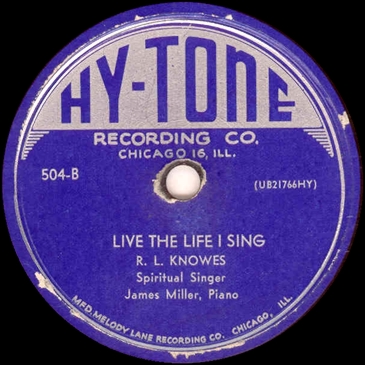
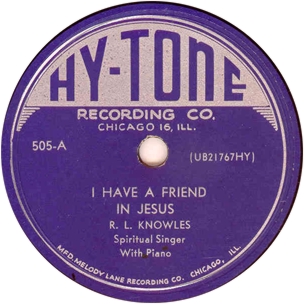
Our source for this session is the minutes of the Board meeting of Musicians Union Local 208, November 6, 1947 (p. 2), wherein we read:
Messers [sic] Freddie Williams and Nathan Rothner of Hy-Tone Records, appeared before the Board as ordered, re the charge filed by member James Miller, that he was not paid for a half hour overtime ($27.50) for a recording session, October 13, 1947. Member Miller, who failed to pay the tax for a former recording engagement, failed to appear.
Mr. Rothner stated that Miller did not report on time, but did the three (3) hour session. He did not recall him doing the overtime, but agreed to mail the Local a check as soon as he returned to his office. THIS ARRANGEMENT WAS SATISFACTORY WITH THE BOARD.
ON MOTION, THE BOARD RULED THAT THE RECORDING TAX FOR TWO RECORDING SESSIONS ($14.82) PLUS A $5.00 FINE FOR NON-APPEARANCE SHALL BE DEDUCTED FROM MEMBER JAMES MILLER'S CHECK, AND THAT THE BALANCE SHALL BE PAID TO HIM.
Note that Williams was still officially with the company (and in the Union), so he made sure to show up, but Rothner had handled the session, and was doing the talking in front of the board. The "former recording engagement" would of course be Hy9, around June 1947.
Cooley recorded with boogie woogie pianist Albert Ammons on two 1946 sessions for Mercury, playing drums on both of them and singing on one. In October 1946, he was performing at George's Cocktail Lounge (211 East 43rd). The Defender ad also noted that Cooley was "formerly with Louis Jordan, and is presently Recording Artist for Hamptone Recording Co." (We haven't found a Hamptone with Cooley on it.) In December 1946, Cooley was featured at the Hurricane Show Lounge (347 East 55th), and billed as "Jack Cooley and His Swing Quartet." In all the Defender ads relating to these dates Cooley is also billed as "The Man That Plays and Sings The Blues."
Probably a couple of months before his Hy-Tone outing, Cooley appeared as the drummer and vocalist on a session credited to the Israel Crosby Quartette and released on Apollo (we still don't know who it was done for originally). One purpose of the session was to feature Buster Bennett, then under contract to Columbia, on soprano sax. Israel Crosby had been playing bass in Bennett's trio. Apollo 390 features Cooley's singing on both sides. The extraordinarly rare Apollo 405, on which Buster did some singing and had to cut the side short, would be released in March 1949.
Jack Cooley (voc -1); St. Louis Jimmy (voc -2) Roosevelt Sykes (p); Lamont "Guitar Pete" Franklin (eg -2); poss. Alfred Elkins (b -2).
United Broadcasting Studio, Chicago, c. October 18, 1947
| UB21813HY (40A added in the shellac) |
Something I'm Going to Be (Cooley) -1 | Hy-Tone 36-A | |
| HY40 CF | Coming Up Fast (St. Louis Jimmy) -2 | Opera 4A | |
| HY43 ODR | One Doggone Reason (St. Louis Jimmy) -2 | Opera 4B | |
| UB21817 | Stop My Evil Ways (Cooley) -1 | Hy-Tone 36-B |
Between the October 13 session by Knowles and the end of its recording binge on December 31, 1947, United Broadcasting went from UB21765 to UB22508 in its UB2000 matrix numbering system—averaging around 10 master takes per day. Were there any overlap in personnel between Hy-Tone 35 and Hy-Tone 36, we would consider the possibility of back-to-back sessions the same day.
Hy-Tone recorded Cooley with just piano accompaniment. The HY40 in the trailoff area on Side A tells us that this session included at least two sides by Saint Louis Jimmy. The St. Louis Jimmys did not appear on Hy-Tone. After it became clear Hy-Tone wouldn't be putting them out, Jimmy Oden released them on Opera 4, with HY40 and HY43 as their matrix numbers. According to collector John Newman (email of August 21, 2006), the accompaniment on these St. Louis Jimmy sides was by Roosevelt Sykes (piano), Lamont "Guitar Pete" Franklin (instrument not hard to guess), and possibly Alfred Elkins (bass). At some point in 1948, Oden must have bought them back from Nathan Rothner and turned them over to his partner at Opera. On Cooley's two sides, then, Roosevelt Sykes was the pianist.
Hy-Tone 36 is so crazily rare that it didn't catch the attention of collectors until August 2018, when a photo of the B side label and a digital transfer appeared at https://archive.org/details/78_stop-my-evil-ways_jack-cooley-mr-blues-cooley_gbia0064396b/Stop+My+Evil+Ways+-+Jack+Cooley+Mr.+Blues.flac. This was quite the coup for the Internet Archives' rapidly expanding 78 rpm pages. Side A was added in October 2018; it had been held back because it was in G condition and hard to transfer (it couldn't be played through with some styli).
Between HY40 and HY43 were once HY41 and HY42, or so we must assume. The session looks to have run to 5 or 6 sides in all, but we can say no more because only Hy-Tone 36 and Opera 4 have come down to us.
"Something I'm Going to Be," amazingly, was recorded by another artist a couple of months later. On December 26, 1947, King brought Dwight "Gatemouth" Moore into a Chicago studio with a band led by Bill Martin—and Cooley's number was among the 20 sides recorded during the epic session. King's third and last single to use material from the session, King 4256, was released in December 1948. It has "Something I'm Gonna' Be" as its A side.
Cooley recovered from his lack of exposure on Hy-Tone. In the fall of 1948 he recorded with tenor saxophonist Buck Douglas for the tiny Square Deal operation, of which he was part-owner (thanks to Daniel Gugolz for alerting us to these releases).
In April 1950, as Miracle was turning into Premium, Jack Cooley cut a session at United Broadcasting that led to two releases on his own C&G label. At least one was also out on Master (UB's house label). Around that time he could be found at the Hob Nob Lounge and Toad's Pair o' Dice, two establishments with which he inked "indefinite" contracts in August 1950 (they were accepted and filed by Musicians Union Local 208 on August 3). In 1951 or 1952, Cooley recorded two singles for the Nashboro label. Then, like so many other artists who had recorded for Lew Simpkins (who was with Premium in the second half of 1950), he followed the A∓R man over to United and in 1953 cut a session for the States subsidiary. Cooley would continue to work the Chicago clubs regularly for the remainder of the decade.
Hy-Tone's next session (there is just enough room in the UB 21000s for somebody else's outing in between) featured a jazz artist, T. S. Mims. It might even have taken place on the same calendar day, though we've estimated it was the next day.
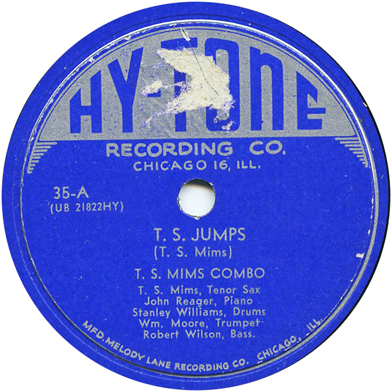
T. S. Mims (ts); William Moore (tp); John Reager (p); Robert Wilson (b); Stanley Williams (d); Dorothy Washington (voc -1).
United Broadcasting Studio, Chicago, c. October 19, 1947
| UB21822HY37A | T.S. Jumps (Mims) | Hy-Tone 35-A | |
| UB21823 | unidentified title | unissued | |
| UB21824HY37B | Dreamy Day Blues (Fenner) [voc DW]-1 | Hy-Tone 35-B |
Tenor saxophonist T. S. Mims, Sr. was a Hy-Tone recording artist, according to a Defender ad from October 9, 1948. Club Playtime, located on the West Side at 2232 West Lake Street, gave all the particulars in its ad: "T.S. Mims and his Hy-Tone Recording Band, Playing his latest releases, DREAMY DAY BLUES, T.S. JUMPS." Earlier in the year, in May, Mims had a long term engagement at George's Cocktail Lounge (211 East 43rd Street). We had a much easier time finding a print reference to Mims' Hy-Tone release than turning up the actual record.
According to his obituary in the Chicago Tribune, Thomas Samuel Mims was born in McCormick, South Carolina, on April 24, 1918. He was playing in Chicago by the late 1930s; according to Junior Mance's interview in Cadence, Mims hired Mance for a gig in 1939 when the pianist was just ten years old.
Mims worked regularly in Chicago from 1946 through 1950. Besides his many club gigs, he was featured, along with DJ Al Benson and Aristocrat artist Andrew Tibbs, in the "Varieties at Midnight" show to raise money for the West Side Urban League ("Urban League Will Present Benefit Show," Chicago Tribune, April 24, 1949, pt. 3 p. 5W). In the early 1950s he was one of the members of the "secret society" on the South Side that included Alton Abraham, Lawrence Allen, and Sun Ra; its more public manifestations were Saturn Research, which was concerned with sound and eventually spawned Abraham and Ra's Saturn record label, and Thmei Research, whose focus was the occult. In November 1950, according to the minutes of the Musicians Union Local 208 Board, T. S. Mims was on an "indefinite" contract with the Ship Lounge (the contract was accepted and filed on November 16). In August 1951, he was working Joe's Rendezvous (a contract for an "indefinite" period was accepted and filed on August 2, 1951).
In January 1952 Mims worked the Country Fair (indefinite contract posted January 17; he posted another contract with the joint, now spelled "Country Fare," on March 6). From April 1952 on through 1954 T. S. Mims held down the house band spot at Martin's Corner (1900 West Lake), one of the premier black and tans on the West Side with a revue format (he posted a contract with Martin's Corner on April 17). In August he worked two weeks at Yamie's Night Club (contract posted on August 7) and toward the end of month he picked up three days at the Fifth Avenue Lounge (contract posted on September 4; Al Smith was temporarily in at Martin's Corner, according to a a contract accepted and filed the same day). In December Mims signed another contract with Martin's Corner (posted on December 18, 1952).
In fact, he eventually acquired an ownership interest in the establishment, according to the Chicago Defender of September 10, 1953: "T.S. Mims and his band are the feature attraction at the new re-opened Martin's Corner, 1900 W. Lake, The owners, T. S. Mims and David Logan annouce new policy entertainment nightly, reduced prices." Mims nonetheless hedged his bets by appearing at other clubs from time to time. In November 1953, for instance, he worked the Paris Club while the Freeman Brothers (Von, George, and Bruz) appeared at Martin's Corner (contracts accepted and filed by Local 208 on November 19, 1953). Mims was back in January 1954 (2-week contract accepted and filed on January 21; contracts for 2 weeks and "1 afternoon" posted on March 4).
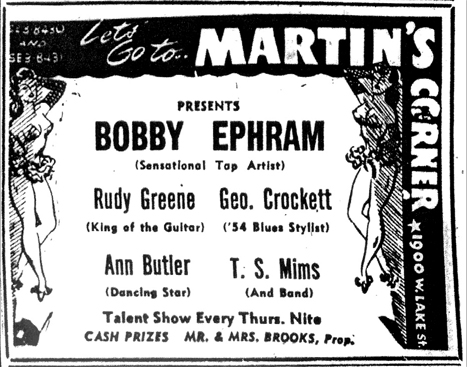
Eventually, Martin's Corner went downhill and Mims lost control of the club. By July 1954 the owners were being identified in ads as Mr. and Mrs. Brooks, though Mims' group was still appearing as the house band. The last Defender ad to mention Mims at the Corner ran on September 4, 1954; his group was promptly replaced by Paul Bascomb's. A blurb for a package show later in September mentioned Mims' band as one of the attractions, but so far as we know it would be his last appearance at such an event. Other tenor-playing bandleaders, such as Red Holloway and Paul Bascomb, had no trouble taking over.
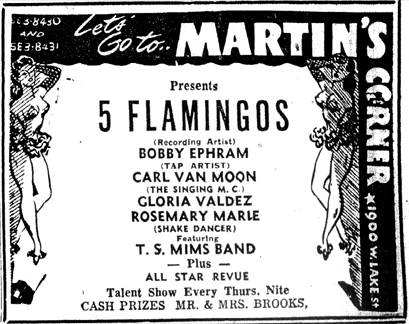
On November 4, 1954, Mims posted a contract for 3 months at the Squeeze Rendezvous (a club that had already failed to pay Jimmy Binkley all the money that was owed him). Sometime during the first half of 1955, T. S. Mims was "erased" from the rolls of Musicians Union Local 208, presumably for nonpayment of "Local tax." When he went ahead anyway and took a job at a joint called the Coral Key (indefinite contract filed July 7, 1955), with John Reager (piano), Leroy Nabors (trumpet), and Bertrand Blanchard (drums), President Harry Gray and the Local 208 Board threw the book at him, socking Mims and the members of his combo with fines that exceeded their weekly pay:
Member T. S. Mims and orchestra failed to appear before the Board as notified....
On motion, the Board ruled that member T. S. Mims shall be fined $250.00 for imperilling the interests of the Local; accepting a job which was on the Defaulter's List of Local 10; failure to file a contract before the engagement was played; and being erased from Local 208 when he accepted the job and employed musicians from Local 208 in good standing—fine to be paid within ten days or Mims shall stand erased and be withdrawn from the engagement at the Coral Key.
On motion, the Board ruled that members John Reagor [sic], Leroy Nabors, and Bertrand Blanchard shall be fined $100.00 for accepting and playing an engagement at the Coral Key with T. S. Mims while he was an erased member of Local 208—fine to be paid within ten days or they shall stand erased and be withdrawn from the engagement at the Coral Key. (Minutes of the Musicians Union Local 208 Board, July 21, 1955, p. 2)
After a month, the situation began to simmer down; though Harry Gray did not relent on the $250 fine, Mims was allowed to keep working at the Coral Key, and on September 1, the Board accepted a $50 check from Mims and approved an installment plan for paying off the rest of the fine. Mims extended his Coral Key engagement in February 1956 (contract posted on February 16).
After 1956, Mims' activity in Chicago became sporadic, at least in the Union locales. At the beginning of 1958, he cropped up at a joint called the Balihy (indefinite contract accepted and filed on January 16). Mims may have had some staying power there, for he posted another indefinite contract with Local 208 on December 18 of that year (now the place was called the "Bali Hi"); however, he appears to have been replaced around the beginning of 1959 (pianist Denni Tillman posted a two-month contract on January 8).
A vocal group record from 1958, on a very small Chicago label called Coin, was billed as T. S. Mims & the Mystics. All we know is that Coin 1500 was released around April of that year (it was mentioned in Cash Box for April 19, p. 40). The lead vocalist was identified on the label as Sabu. Coin 1500 was the first of maybe four releases on what was probably a 45-rpm-only operation. It was owned by one Frank McNulty, whose name shows up regularly in the composer credits. A listen to "Love You Betty" indicates a rock and roll group, with jangly lead guitar and no tenor saxophone. So we are confident that T. S. Mims Sr. was not on it. Sabu, however, could have been the senior Mims' long-time drummer, Bertrand Blanchard. It's possible Tom Mims (T. S. Mims Jr.), who would have been a teenager at the time, was also involved. To be researched.
During the same period, Mims became active in the Cronies' Men's Club. He appeared in a group photo with the officers of the club, on the occasion of an event at the Parkway Ballroom ("Cronies Stage Dance," Chicago Defender, June 4, 1958, p. A15). At a subsequent Cronies event, held at what was then called the El-Sid Trianon Ballroom, Mims' band performed ("Cronies Sponsor Cabaret Show-Dance," Chicago Defender, December 3, 1963, p. 14).
Mims' name does not show up on the Local 208 contract lists again until June 22, 1961, when he filed an indefinite contract with the Keyboard Lounge. He dropped out of sight again until the Local 208 Board meeting minutes for November 1, 1962 recorded his contract with the Rand Bowl. (The Rand Bowl was a White venue, as was Rick Casares' Pro Bowl, where Mims was working in February 1963; his contract was accepted and filed by Local 208 on February 7.) Bertrand Blanchard, aka "Sabu," the drummer in Mims' combo on many occasions in the 1950s, died from a stroke on November 26, 1964, aged just 36. He left a wife and 8 children ("Mass Said for Musician Bertram [sic] Blanchard, 36," Chicago Defender, December 5, 1964, p. 14)
On January 21, 1965, Mims posted an indefinite contract with the Holiday Inn. Apparently the management was pleased with the results, because his group started a 7-week engagement on January 29 (contract accepted and filed on February 4). We don't have access to further doucmentation of his Union contracts after Local 208 finally merged with Local 10 in January 1966.
When Robert Campbell talked to his son, T. S. Mims, Jr. in 1994, he reported that his father was living in Florida and still working. T. S. Mims died in Chicago on August 26, 2000.
The Mims Hy-Tone release is by all indications extremely rare. We were beginning to wonder whether one would ever turn up when we heard from Lou Rallo, who featured both sides of Hy-Tone 35 on his radio show, "The Low Budget Blues Hour." We have now located a second copy.
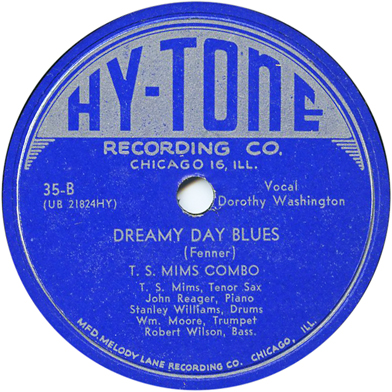
On the "Dreamy Day Blues" label there is a credit "Vocal Dorothy Washington" to the right of the center hole, and the suffix 37B in the shellac after the matrix number UB21824 HY. So it looks as though the original intention was to release the single as Hy-Tone 37. Senabelle Richie Fenner, identified by the Chicago Defender in a February 23, 1952 article as a "writer, poet, and song-stylist, whose compositions have been recorded by numerous artists," was also co-composer for "Drinkin' Blues" by Tom Archia and his All Stars with Dr. Jo Jo Adams handling the vocals; released on Aristocrat 802, "Drinkin' Blues" was recorded in July 1947. She was further responsible for the risqué "Baseball Blues," cut by Clarence Samuels with a Porter Kilbert band in December 1947 and released on Aristocrat 1003.
The A side trail-off area carries a 37A suffix after the UB21822 HY. "T. S. Jumps" is a fast jazz number, based on "Sweet Georgia Brown" and situated somewhere in the transition from Swing to Bop. The band, well coordinated as a working unit ought to be, does the in chorus, Mims follows with three full choruses, working up to some R 'n B honks and screams in the third, then the band takes the number out. "Dreamy Day" (like "Drinkin' Blues") reveals a Fenner fixation on the excessive consumption of intoxicants. Dorothy Washington—a regular on Garfield Boulevard performing in the revue at the Hurricane Lounge (349 East Garfield) with Jo Jo Adams—sings the vocal in a Sheba Griffin-like manner, accompanied rather busily by Mr. Mims. The centerpiece of the record is an absolutely stunning slow blues chorus from the saxophonist, followed by a second chorus with some accompaniment by the trumpet that is nearly as good. The vocalist returns and there is a quick tag by the band.
We do not know of any other T. S. Mims records. There should have been some. On the strength of his Hy-Tone single, he was a strong saxophonist with a full, passionate tone, inspired by Hawk and Illinois Jacquet, and able to please jazz fans along with those bar patrons who expected more obvious forms of excitement.
We are not conversant with the release schedule for the latter-day Hy-Tones, but like so much other material recorded in anticipation of the Petrillo recording ban set for January 1, 1948, Hy-Tone 35 appears to have been held off till well into that year.
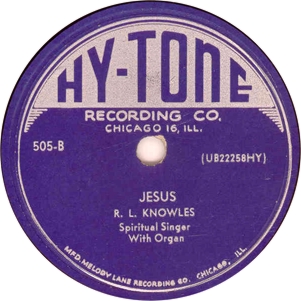
Rothner was sufficiently interested in the Reverend R. L. Knowles to bring him back for yet a third session toward the end of the year. The third session came to light only in April 2006, when Tom Kelly located a copy of Hy-Tone 505. Rothner went with an organist on Knowles' last session: assuming he was still in good odor with the company, James Miller was the obvious choice.
R. L. Knowles (voc); prob. James Miller (org).
United Broadcasting Studios, Chicago, c. December 4, 1947
| UB22258HY | Jesus | Hy-Tone 505-B | |
| unidentified titles? | Hy-Tone (unissued) |
On "Jesus," Knowles is accompanied by an organist. If there are any more 500-series Hy-Tones still extant, we figure they came out of this session.
Well after his Hy-Tone days, R. L. Knowles recorded again for Vee-Jay in 1958 with the Jackson Sextet: the act was identified on the label as "Knowles and Jackson Sextet." There were two releases from that session. R. L. Knowles died in Los Angeles on September 6, 1971.
Our profile on Knowles was based on Anthony Heilbut's notes to Working the Road: The Golden Age of Chicago Gospel, Delmark Records DE-702, released in 1997, and on research by the late Eric LeBlanc.
Other Hy-Tone gospel releases are 45 rpm singles from the 1960s, on what of course was a completely different label. See Appendix B below.
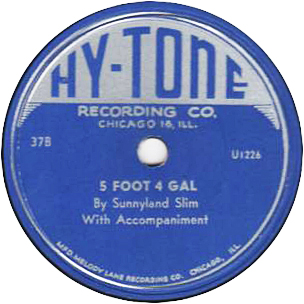
Dating is fuzzier than we would like on the second and final Sunnyland Slim session for Hy-Tone. This ridiculously obscure outing at Universal Recording (the only time that Hy-Tone brought its artists there) has been conventionally placed in 1948. But given what we know about Freddie Williams effectively dropping out of Hy-Tone, and about the disappointing sales of its releases, a date in the last quarter of 1947 becomes highly probable. Hy-Tone was unable to record at all during the first half of 1948, because of the recording ban imposed by the American Federation of Musicians and enforced with some vigor by the Chicago locals. Once the record companies started sneaking sessions in again (around the middle of the year) we doubt that Hy-Tone could afford any more of them. It would help to see more matrix numbers in the U000 series, but by extrapolation from those that appear on Vitacoustic recordings from the last quarter of 1947, our present conclusion is that the last Hy-Tone session took place in December of that year.
Sunnyland Slim [Albert Luandrew] (voc except %, p); prob. Oliver Alcorn (ts except %); Sam Casimir (eg); prob. Andrew Harris (b); unidentified (d); Harmon Ray as "Peetie Wheatstraw's Buddy" (voc on %).
Universal Recording, Chicago, prob. December 1947
| U1226 | 5 Foot 4 Gal | Hy-Tone 37B, Classics 5013 [CD] | |
| U-1231 | Dog Eatin' Man % | Hy-Tone 38A | |
| U-1232 | Miss Irene % | Hy-Tone 38B | |
| U1235 | I've Done You Wrong | Hy-Tone 37A, Classics 5013 [CD] |
Sunnyland Slim's second Hy-Tone session is seriously underdocumented. Just two sides appeared under Slim's name, "5 Foot 4 Gal" and "I've Done You Wrong." The master prefix shows that these were recorded by Universal Recording on Wacker Drive. Apparently Hy-Tone was no longer using United Broadcasting (which was hardly slacking off its activity in December 1947; the studio would begin its decline in 1950). Hy-Tone 37 was reissued in 2001 on Classics 5013, Sunnyland Slim 1947-1948.
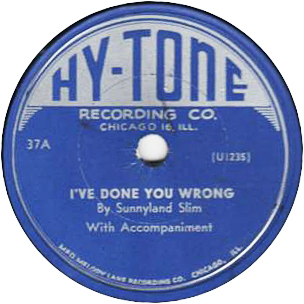
Even more obscure are the two sides credited to "Peetie Wheatstraw's Buddy." U-1232 was misspelled "Miss Irone" in an old issue of Blues Research. The sides were not included in the Sunnyland Slim reissue series on Classics, most likely because, as with the original Hy-Tone 33, the compiler couldn't find a copy of Hy-Tone 38. The release is so little known that Paul Garon, the expert on Peetie Wheatstraw, drew a complete blank when we asked him about it.
"Peetie Wheatstraw's Buddy" was a guest vocalist. Harmon Ray was born in Indianapolis in 1914. He apparently acquired his moniker working with Peetie Wheatstraw in the 1930s. According to Dixon, Godrich, and Rye, Ray recorded under the the name Peetie Wheatstraw's Buddy on a Joe McCoy session for Bluebird (which took place on January 30, 1942). Ray was in the US Army from 1942 to 1946, serving in France during the later part of his hitch. (Our thanks to Dirk Vandervee for the background on Ray, in an email of February 24, 2003; see also Living Blues, March 1976, pp. 14-15).
Subsequently, according to Fancourt and McGrath, Ray recorded at least one unissued side for J. Mayo Williams, supposedly in 1947, with Eddie Boyd accompanying him on piano; "Xmas Blues" has been distributed with copies of Paul Garon's book on Wheatstraw.
Ray cut just one more session after his Hy-Tone outing. As Herman "Peetie Wheatstraw" Ray, he did four sides in New York for Decca, on May 20, 1949, with a Sam Price band (Fancourt and McGrath put J. T. Brown on tenor sax and Lonnie Johnson on guitar, but on the two sides we have heard there's no nanny-goat vibrato, even during a tenor sax solo, and the guitarist just accompanies). It could be that Mayo Williams got Ray the session, but there's no evidence that he supervised it.
All four sides were released, though not in the order indicated by the numbers. Decca 48107 was out in July 1949; perhaps the number in praise of Harry S Truman was deemed more salable. In any event, Billboard was fairly positive about it (July 16, 1949, p. 113). Decca 48105 got a distinctly unenthusiastic review out of Billboard on September 24, 1949 (p. 104). Decca 48105 and 48107 may not be plentiful today, but are a lot less obscure than Hy-Tone 38. Ray is miked better on the Decca session than on the Hy-Tone but is audibly the same singer.
As many as 6 masters that remain unaccounted for: U1227 through U1230, U1233, and U1234. Even if U1227 through 30 turn out to have been allotted in a block to another artist, U1233 and 34 need tracing.
Neither existing discographies nor the notes to the Classics Sunnyland Slim reissue identify the accompanists. The tenor saxophonist, who solos on both sides of Hy-Tone 37 but isn't heard on Hy-Tone 38, is a member of the rough and furry school: if it isn't Oliver Alcorn, who is known to have recorded with Sunnyland in 1948, Eddie "Sugarman" Penigar comes next to mind. Although not mentioned in LFP or in the Classics notes, a drummer was present on the session (using brushes and not accorded much prominence, but easier to hear on "I've Done You Wrong," and often making regular use of his bass drum on Hy-Tone 38).
On Hy-Tone 38, the balance favors the guitar over the piano (which won't prevent anyone from recognizing Sunnyland Slim) and both sides feature guitar solos. On "Dog Eatin'," the pseudonymous vocalist calls out, "All right, Sammy, let's take it now." On "Miss Irene," it's "All right, Sammy, let's get it now." That would point to Sam Casimir, a prolific session guitarist for blues in Chicago during this period. (Fancourt and McGrath, perhaps having heard of the calls to "Sammy," put Sam Price at the piano on this session, but Price didn't work for Hy-Tone, no one would confuse him with Sunnyland Slim, and each call is immediately followed by a guitar solo.) We know little about Sam Casimir's later activities, though he may be the guitarist on a James Scales jazz session, done for Marvello in 1964 or 1965; his brother Bill, who played tenor sax, remained on the Chicago scene into the 1970s.
After his Hy-Tone sides, Sunnyland Slim recorded prolifically for many years in Chicago, making the rounds at such labels as Opera (later reissued on Chance), Mercury, Tempo-Tone, JOB, Parkway (picked up and released on Regal after that operation quickly folded), his own Sunny label, Mercury again, JOB again (he may have owned a piece of it for a while), Blue Lake, Club 51, Cobra, LaSalle, and Miss. In 1960, he made an LP for Prestige; he appeared on many revivalist blues labels thereafter. In his later years, he was revered as an elder statesman of the Chicago blues. Sunnyland Slim died in Chicago in 1995.
Hy-Tone's recording activities were over when Rothner supervised the second Sunnyland Slim session; the label would not survive the recording ban that came down from the American Federation of Musicians on January 1, 1948.
Hy-Tone ground to a close toward the end of 1948, when Rothner received an offer from Syd Nathan of King Records for eight sides, getting a generous offer of $2,000 plus royalties. It was a lease deal, not an outright sale. Memphis Slim had been registering hits with Miracle and King wanted in on the action. After acquiring the masters King didn't care for the sonics on some of them, so four titles were quietly remade in January 1949. (One doggone reason for keeping quiet: Memphis Slim was still under contract to Miracle at the time!) King consequently put out all 8 of the titles Slim had made for Melody Lane / Hy-Tone, but only four of the sides were reissues. The King remakes can be heard on Blues Collection 160142, Memphis Slim: The Complete Recordings Vol. 3 1948-1950, a French CD released in 2001. (We are indebted to Jean Buzelin's well researched liner notes for this compilation.)
The Memphis Slim deal gave Rothner his out. Said he, "When I sold the Memphis Slim masters, I grabbed the money, paid my debts, and ran. That was the end of Hy-Tone." His building at 118 East 30th was full of boxes of overstock that would have to be dealt with. Rothner recalled
I had my rooms stuffed with records, and so I burned them all when I left 118 East 30th. Turned out all the records were worthless. I made a mistake—instead of pressing up 500 copies I pressed up 5,000 copies, because individually they would be cheaper, so I had a lot of leftover stock. I would press records up for 17 cents to 19 cents a copy, and sell them wholesale for about 40 cents a copy, and they would sell at retail at 79 cents a copy.
The company was definitely already inactive when Cash Box ran a weirdly delayed review of Hy-Tone 29 by Floyd Smith. It appeared on March 5, 1949 (p. 14), on a record that was more than two years old, from a company that wasn't recording any more. In those days Cash Box could be slow out of the gate (a review on the same page of John Lee Hooker's "Boogie Chillen" confesses, "Music ops know about this one already"). We suspect that Rothner, knowing that Smith's trio was still pulling them in at the Circular Bar and that Cash Box catered to juke box operators and manufacturers, figured he might still be able to unload a few of his room-stuffers to those who serviced other juke box routes.
Ironically, if Rothner had had a lot less overstock sitting in boxes, he might have found someone to take it off his hands, and we wouldn't be having so much trouble finding some of his issues today.
Rothner's wry recollections speak for many an indie record entrepreneur.
The record business was not as simple as it sounded. Every time we would record a record, we would say, "That's a million seller." And it never happened. I never really hit it big. I paid Al Benson $50 once and he played one of our records all day, but it did not help. We would make records at Union scale and had to pay the studio by the hour, and a four-hour session could really add up.
Let's review those stark economics. For a standard 4-side, 3-hour session with a vocalist listed as leader, and Freddie Williams' seven-piece ensemble, paying everyone Union scale ($82.50 for the leader, $41.25 each for the sidemen) would have cost the company $370.75. (Three hours of Sunnyland Slim plus guitar and bass would have been a bargain at $165.) We don't know studio costs with such exactitude (and Universal would have charged more than, say, Chicago Recording Company), but $60 for 3 hours seems reasonable for the era. (Bob Koester told us that in St. Louis, which had far fewer studios competing for business, charges ran to $20 or $25 an hour.) Mastering was extra. At 20 cents revenue per record sold (wholesale price minus pressing costs), Hy-Tone needed to move 2150 78s just to recoup the recording costs for a full-dress date with Freddie Williams leading, and over 1100 to pay off a (4-side) Sunnyland Slim outing. This is assuming that distributors paid Hy-Tone for all of the records they moved (not a safe bet in the music business, then or now). And we haven't yet factored in royalties, advertising and selling costs (including the bills Williams and Rothner had to slip to Al Benson), or taxes. Nor have we reckoned with the $400 or more tied up in 2000+ unsold pressings of each single, plus the taxes on this unsold inventory. (Distributors might not pay up, but pressing plants still expected to see their money.)
In 1950, Freddie Williams, perhaps figuring that Al Benson got the better end of the deal, went to work for disk jockey Jack L. Cooper. His title was assistant, but clearly he got an occasional on-the-air assignment. In 1953 he joined the jazz-oriented local radio station WAAF as a DJ; in 1954 the fans voted him the top DJ on the station. In 1954 Williams was also elected to the Examining Board for Musicians Union Local 208 (see the Board minutes for January 7).
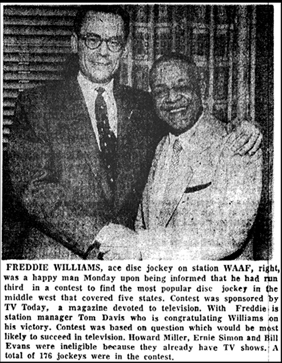
Freddie Williams was completely out of the recording business when he was interviewed for a Chicago Defender article in January 1953, which ran as part of a "Gone, But Not Forgotten" series. He was broadcasting the early morning jazz show on WAAF from his record shop. But the Defender did not mention anything about Williams owning a record shop or a label. The theme of the feature was that here was a man of considerable achievement who has been utterly forgotten today. The photo of Williams showed a man who looked to be in his late 60s or early 70s. However, when Freddie Williams died of lung cancer at Billings Hospital on August 21, 1955, he was just 56 years old. The seriousness of his condition was not publicized: Cash Box (August 13, 1955, p. 25) had Williams out of the hospital and "hoping to get back to his WAAF mike but soon." The death certificate listed his occupation as radio announcer. On August 27, 1955, the Defender ran a story titled "Fans Mourn Freddie Williams," from which we were able to learn significant details about his life. Cash Box ran Williams' obituary on September 3, 1955 (p. 21). WAAF hired The Great (later The Magnificent) Montague to replace him (Cash Box, October 1, 1955, p. 31).
Nathan Rothner continued his Independent Record Distributors until 1952, but his main line of work remained the jukebox business. Over time, he branched out into other vending machines, such as gumball machines. Eventually one of his sons took over and he retired. Rothner never sold Hy-Tone to anyone, but his paperwork and masters were abandoned or destroyed when he left his buildings. Interviewed on September 30, 2002, at the age of 92, he talked about his Hy-Tone experience with great fondness. Despite his lack of success in the record business, it was an endeavor that proved most exciting for him.
Nathan Rothner died on February 9, 2003 in Chicago; he was buried in Jerusalem. The last of the Hy-Tone artists, Charles Waterford, died in Los Angeles on February 1, 2007.
Our work with Hy-Tone is unfinished.
To help dispel confusion, we need to mention that Hy-Tone in Chicago had nothing to do with a contemporary small label called Hi-Tone. Hi-Tone was based in the New York City area; its formation was announced in Billboard on March 12, 1949. It was a subsidiary of Bob Thiele's small company, Signature (which began its operations in 1940 and resumed recording in late 1943). In his collection, Art Zimmerman has a Hi-Tone 276 (Tom Kelly also has a copy of this release). One side, matrix HS 2137, features vocalist Eugenie Baird on "Charley My Boy"; the label credits "The Scott Fisher Foursome" with the accompaniment. The other side, HS 2126, is by singer Larry Douglas; "Dear Hearts and Gentle People" is acompanied by Scott Fisher's Pile-Drivers (one wonders whether the groups differed in personnel or merely in attitude). The address around the rim of the label is explicitly attributed to Signature Records, whose location is given as one of the Connecticut suburbs. Most Hi-Tones featured the pop music of the era. Hi-Tones came in a variety of label colors (some red with white print, some red with black print, and so on), and once the company began pressing on vinyl Hi-Tones were pressed in several different colors. Not all Hi-Tones mention the Signature connection on the label.
The first record company to call itself Hytone (no hyphen) emerged in 1921; it employed a black label with gold print, or a red label with gold print, and recorded blues, jazz, and gospel. Hytone artists included James P. Johnson and Lucille Hegamin. The parent entity was "The Indestructible Phonograph Company" (neither phonographs nor phonograph records exactly qualified in those days!). Hytone was a sister label to Arto and Bell; the same releases appeared in coordinated fashion on all three.
Well after Williams and Rothner's Hy-Tone closed its doors in Chicago, two unrelated labels with the same name sprang up in a different parts of the country. The first Hy-Tone, run by one Steve Samuel out of Queens, New York, operated from 1957 to 1959 and recorded soul singer Little Mack as well as an eponymous vocal group.
The second Hy-Tone, operating out of addresses in Pacoima, California, and Los Angeles, specialized in gospel and opened in 1964. The second edition of Bob McGrath's reference, The R&B Indies (Vancouver: Eyeball, 2006) sorts out the two latter-day Hy-Tones, which were confused in the first edition.
Click here to return to Red Saunders Research Foundation page.